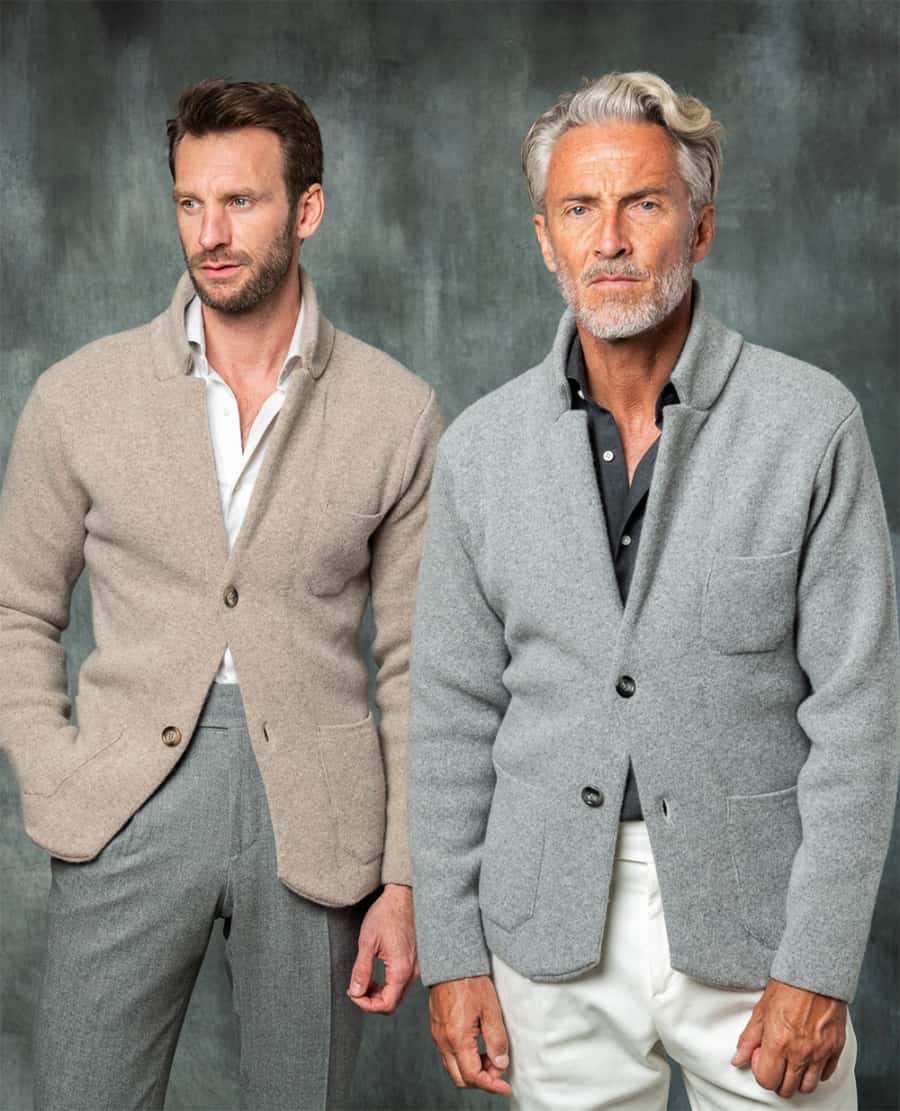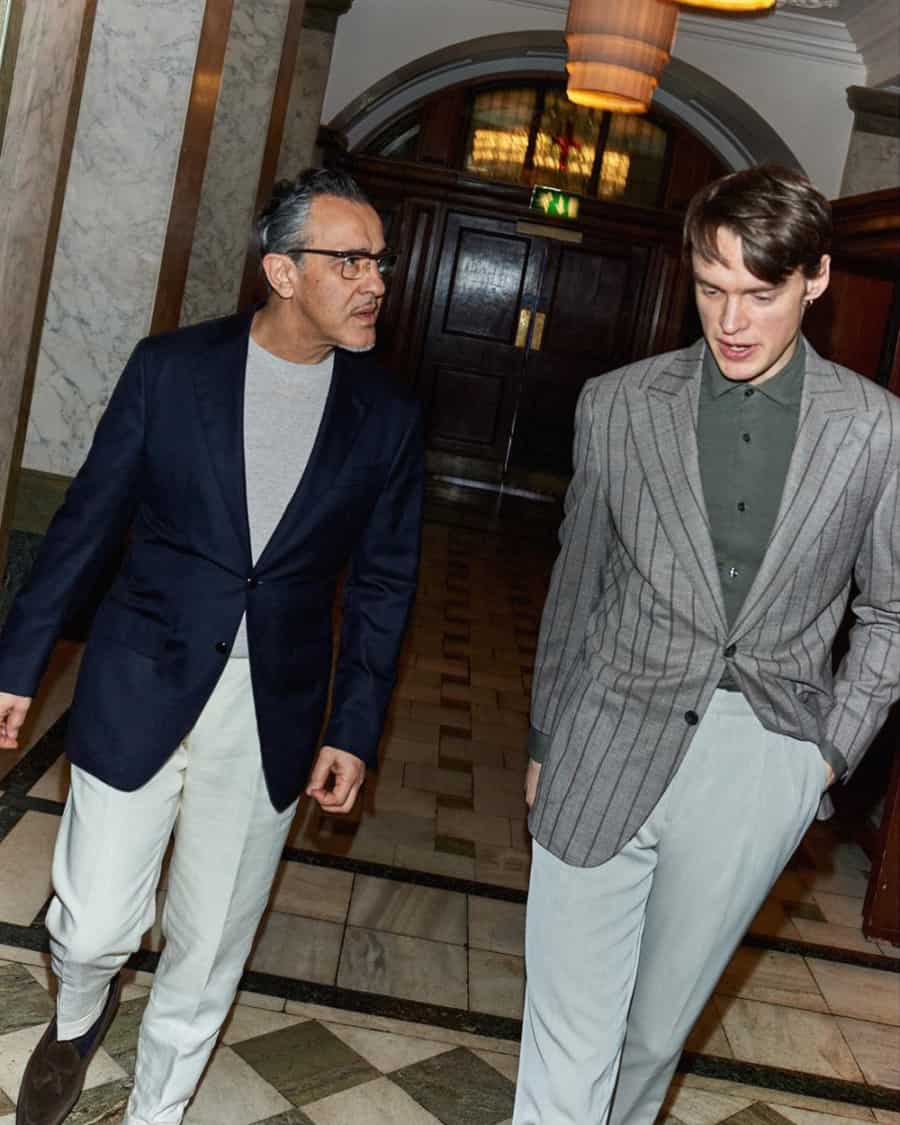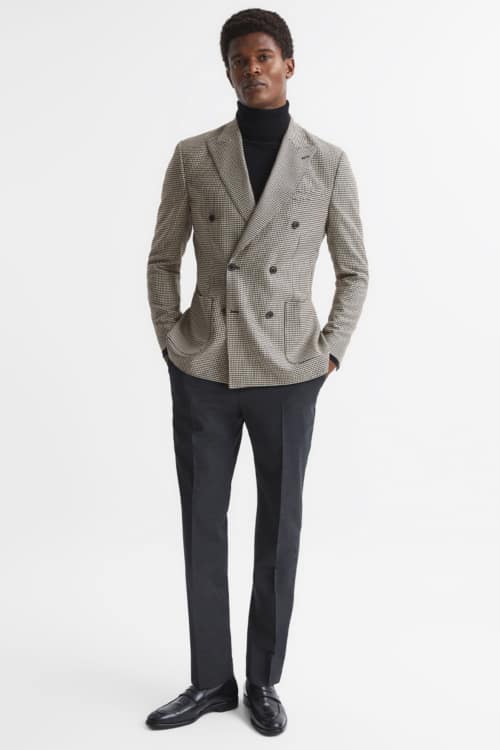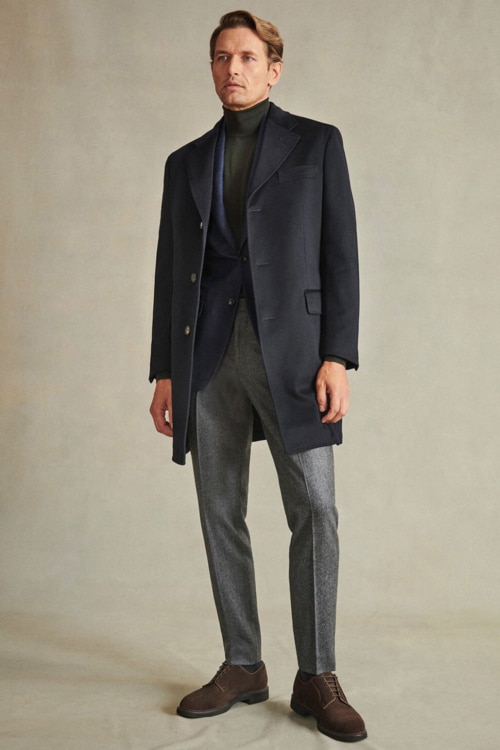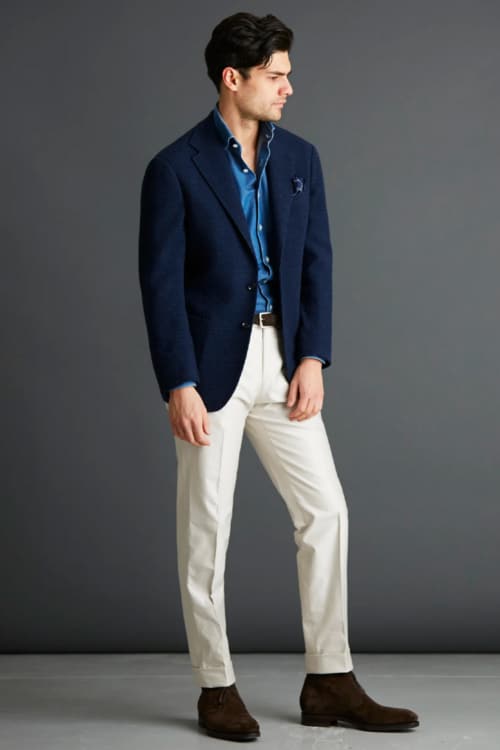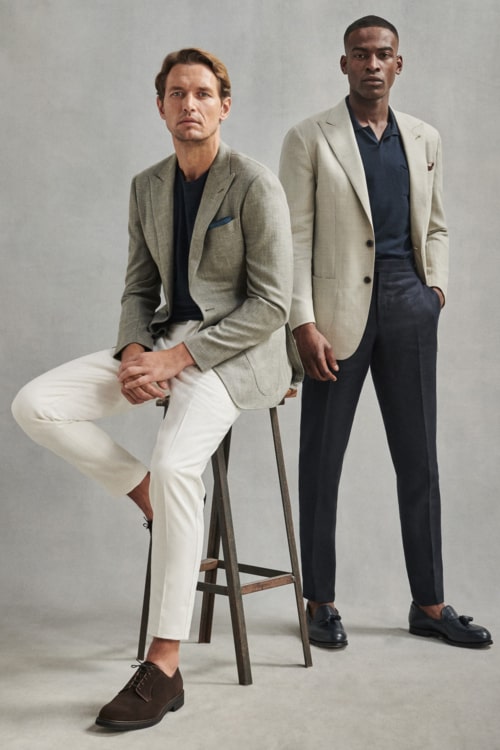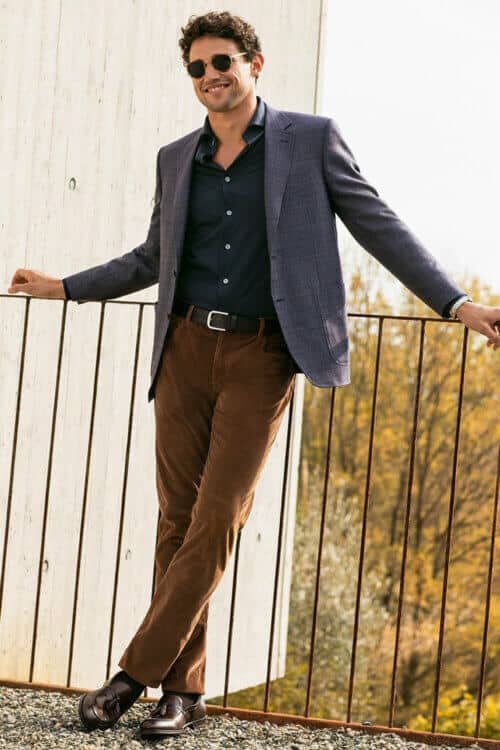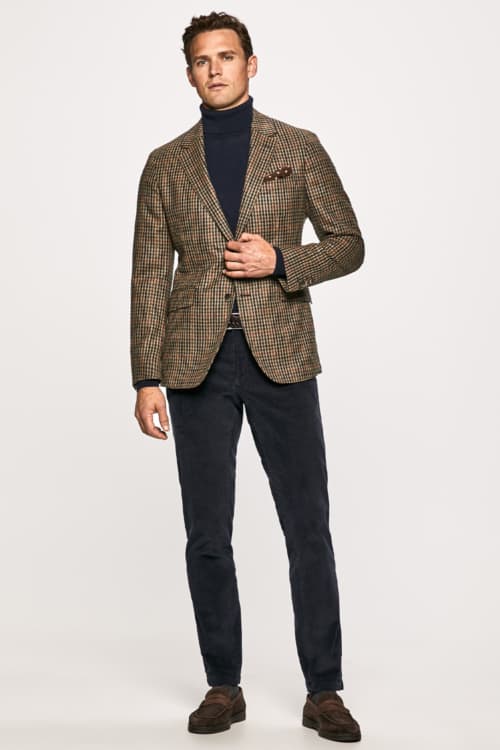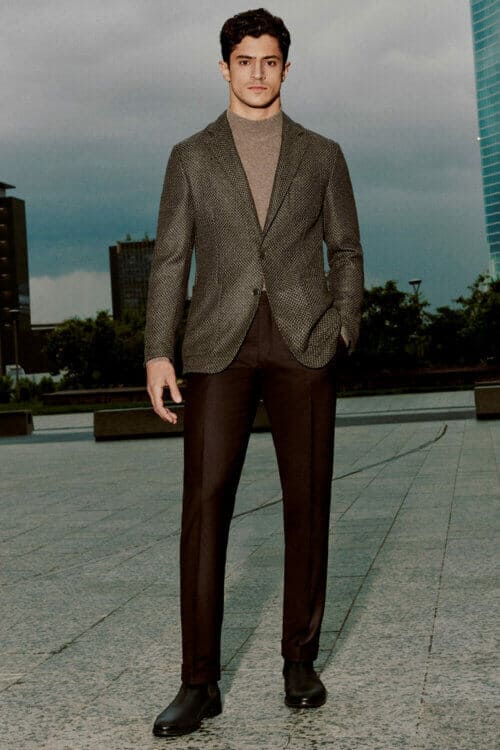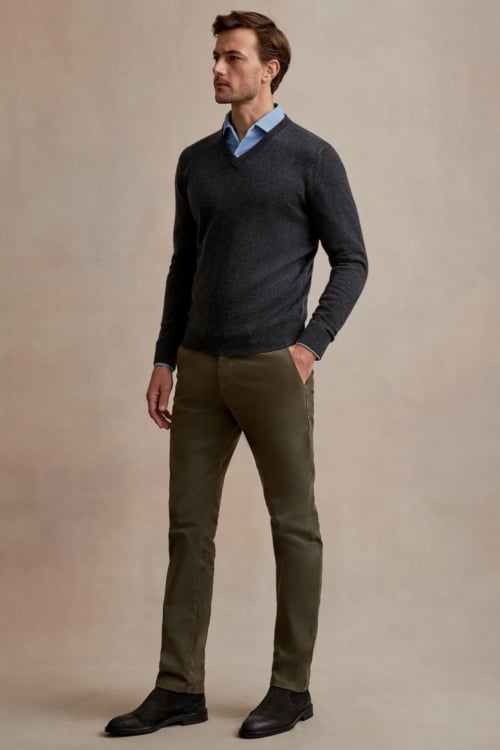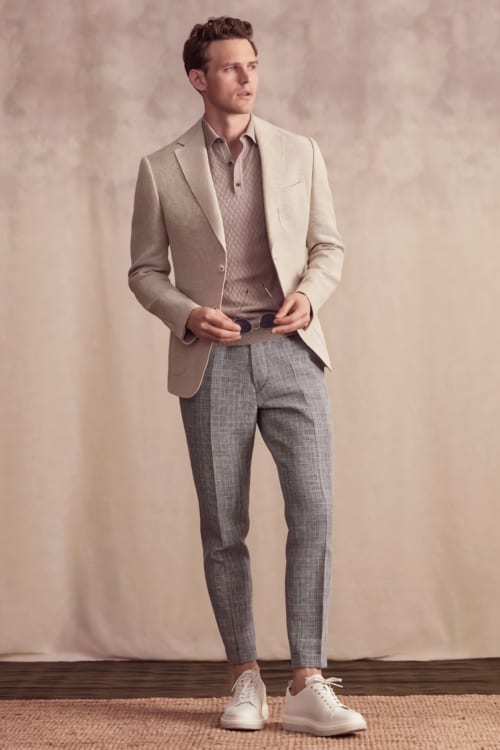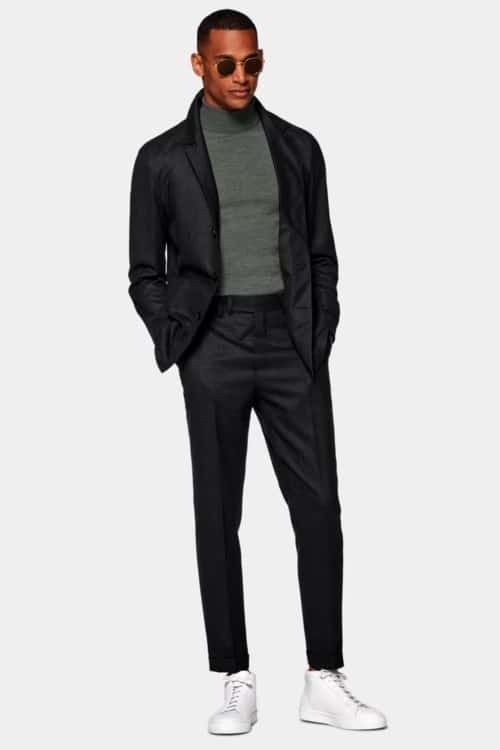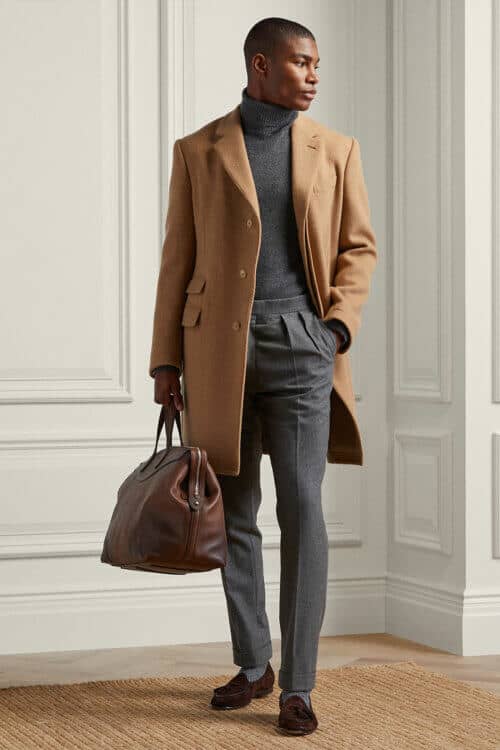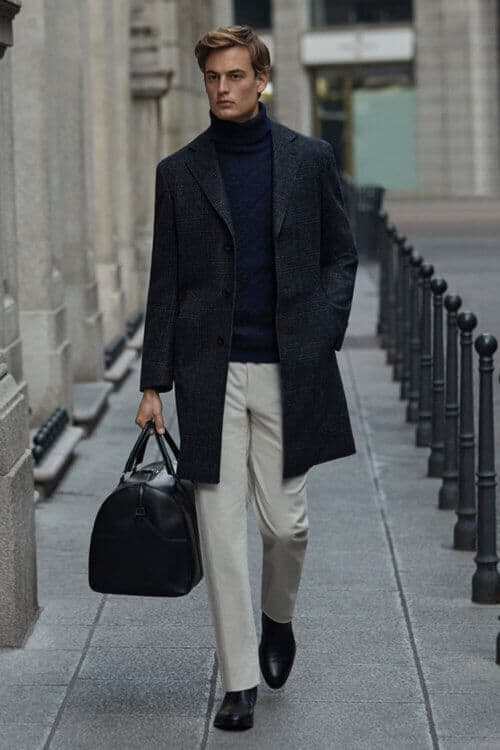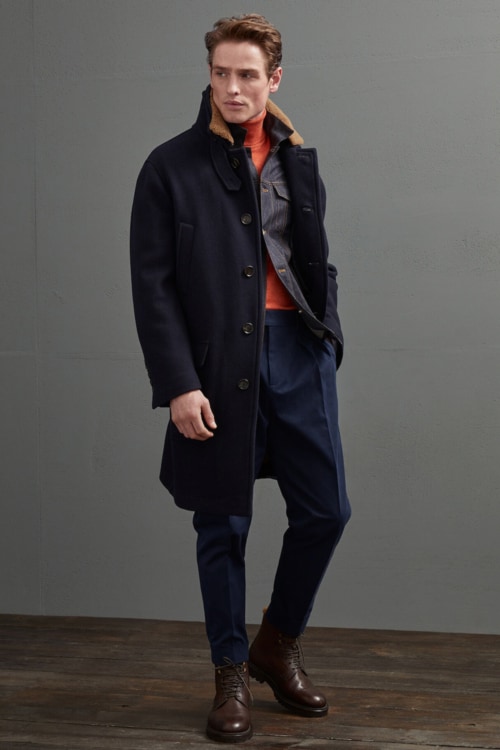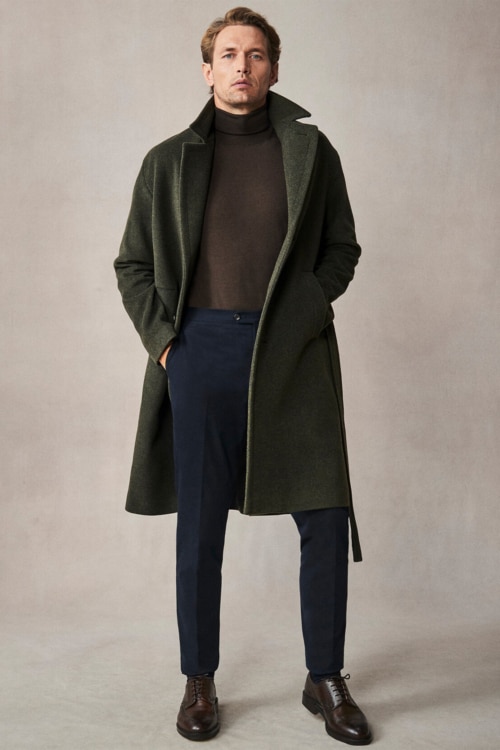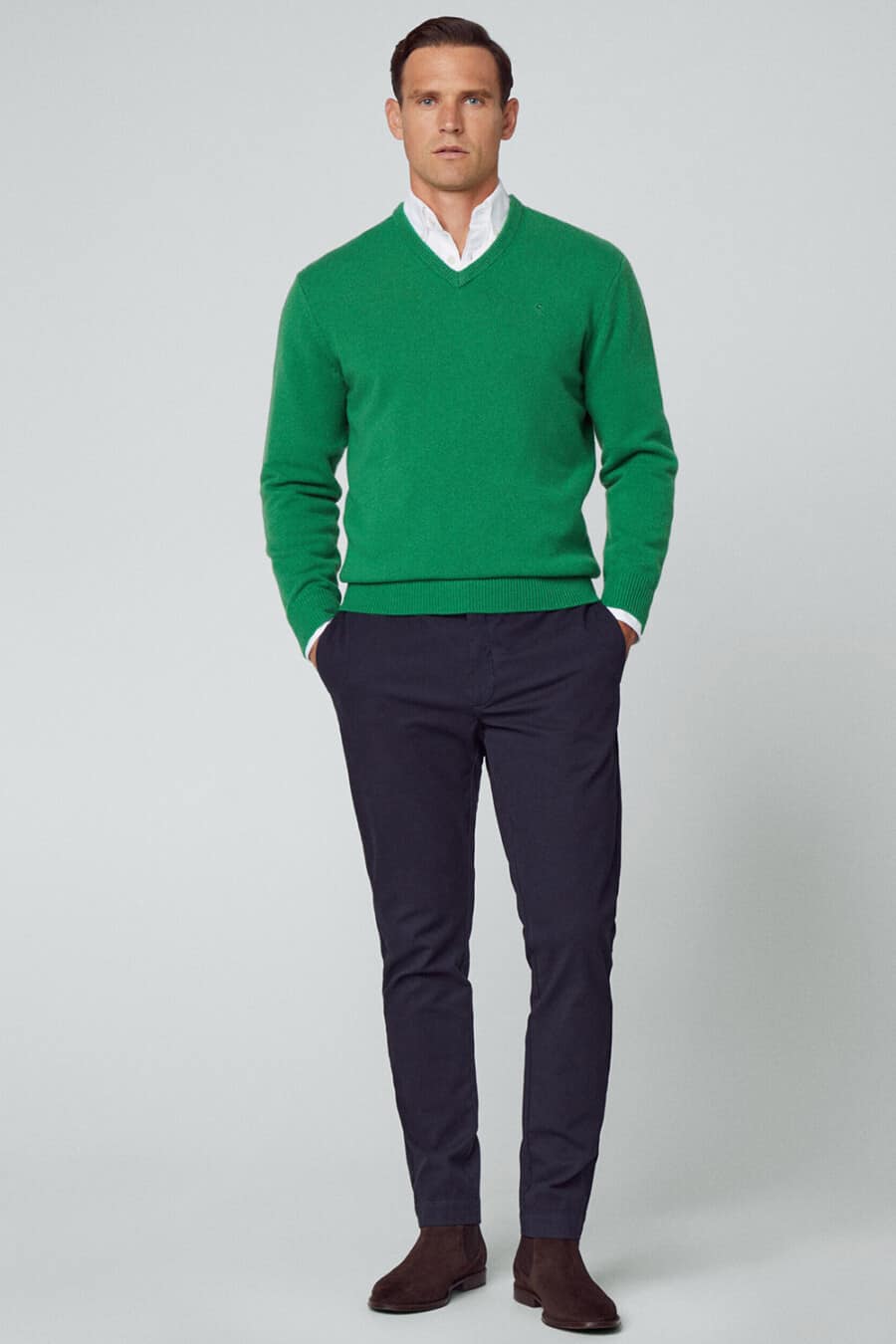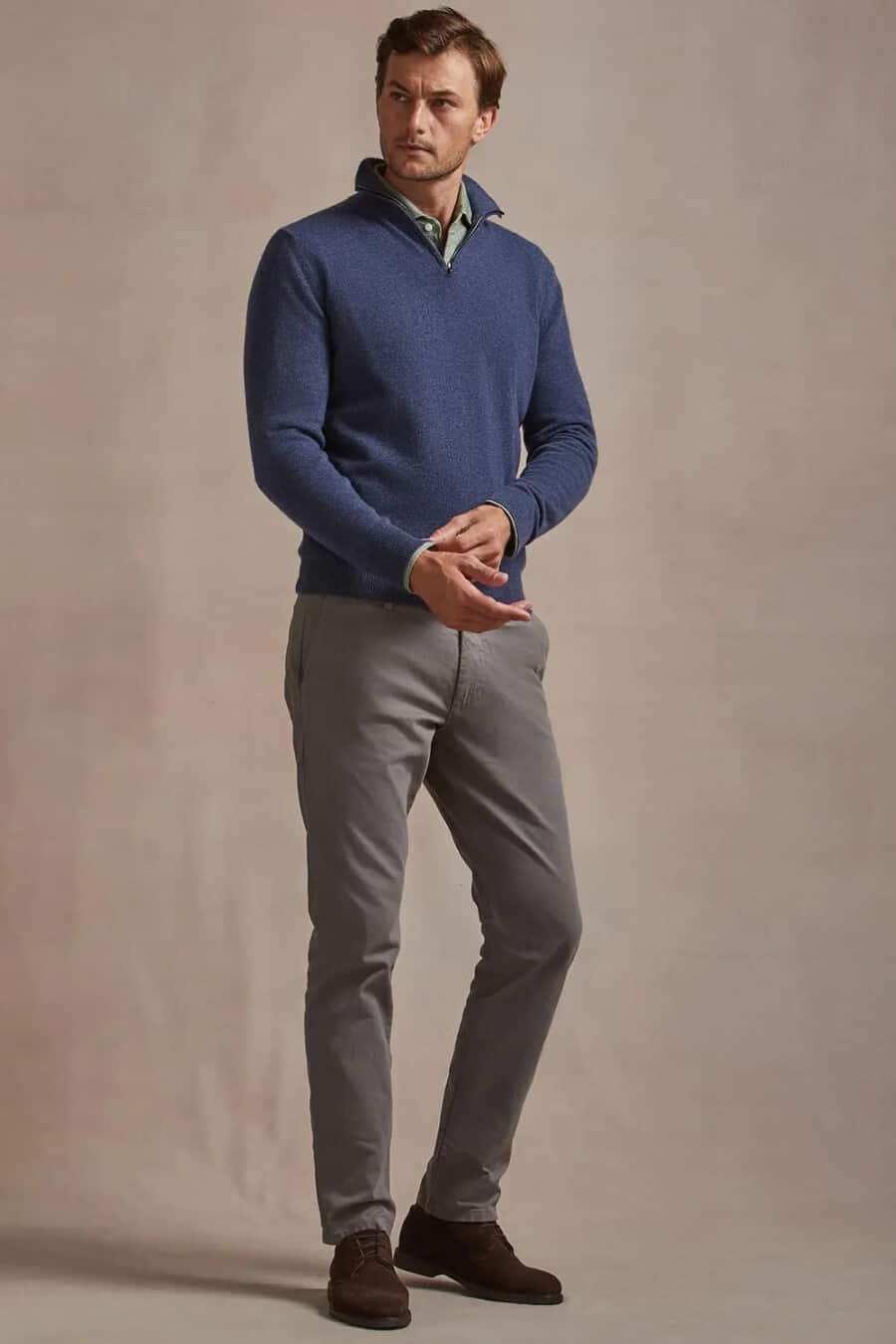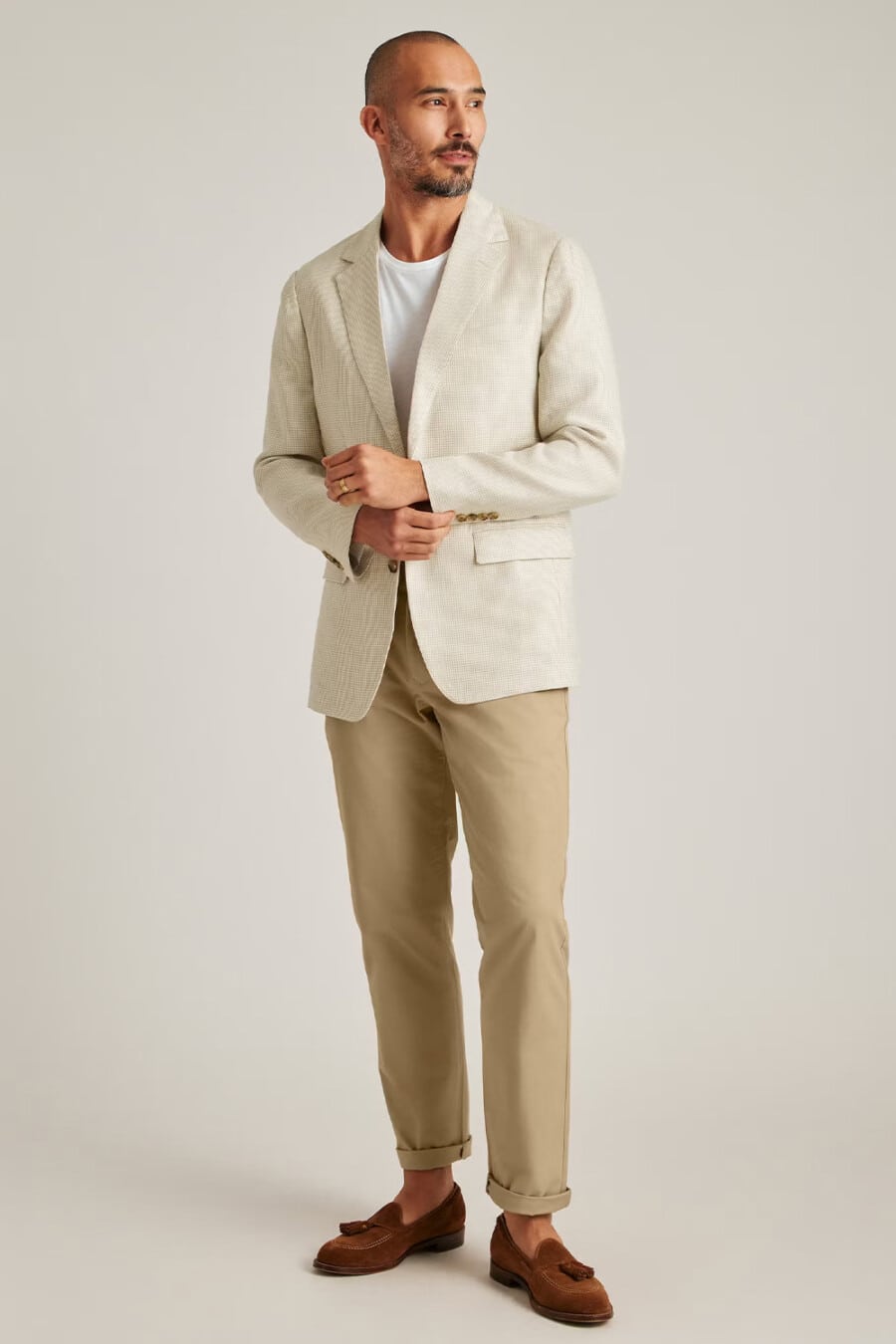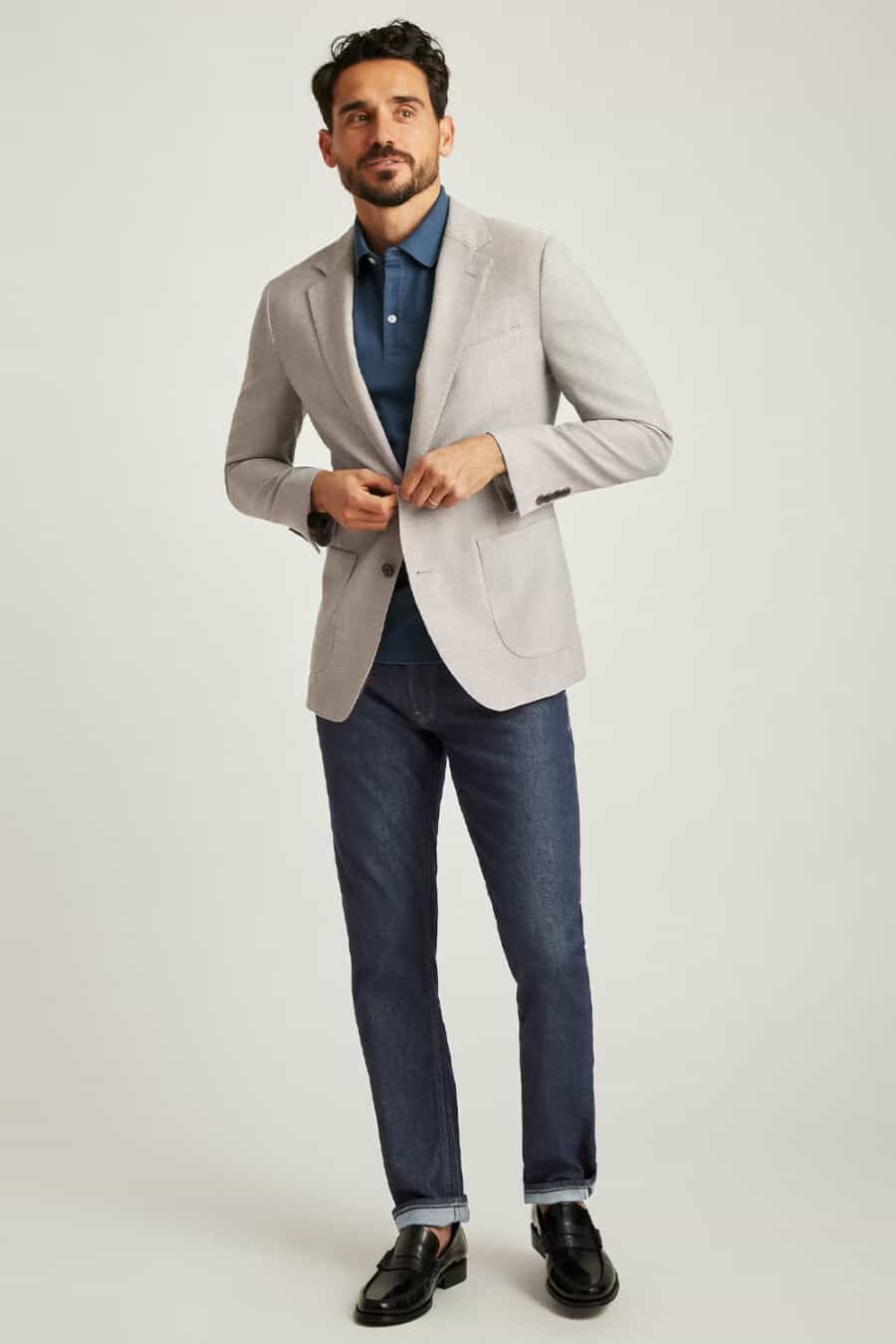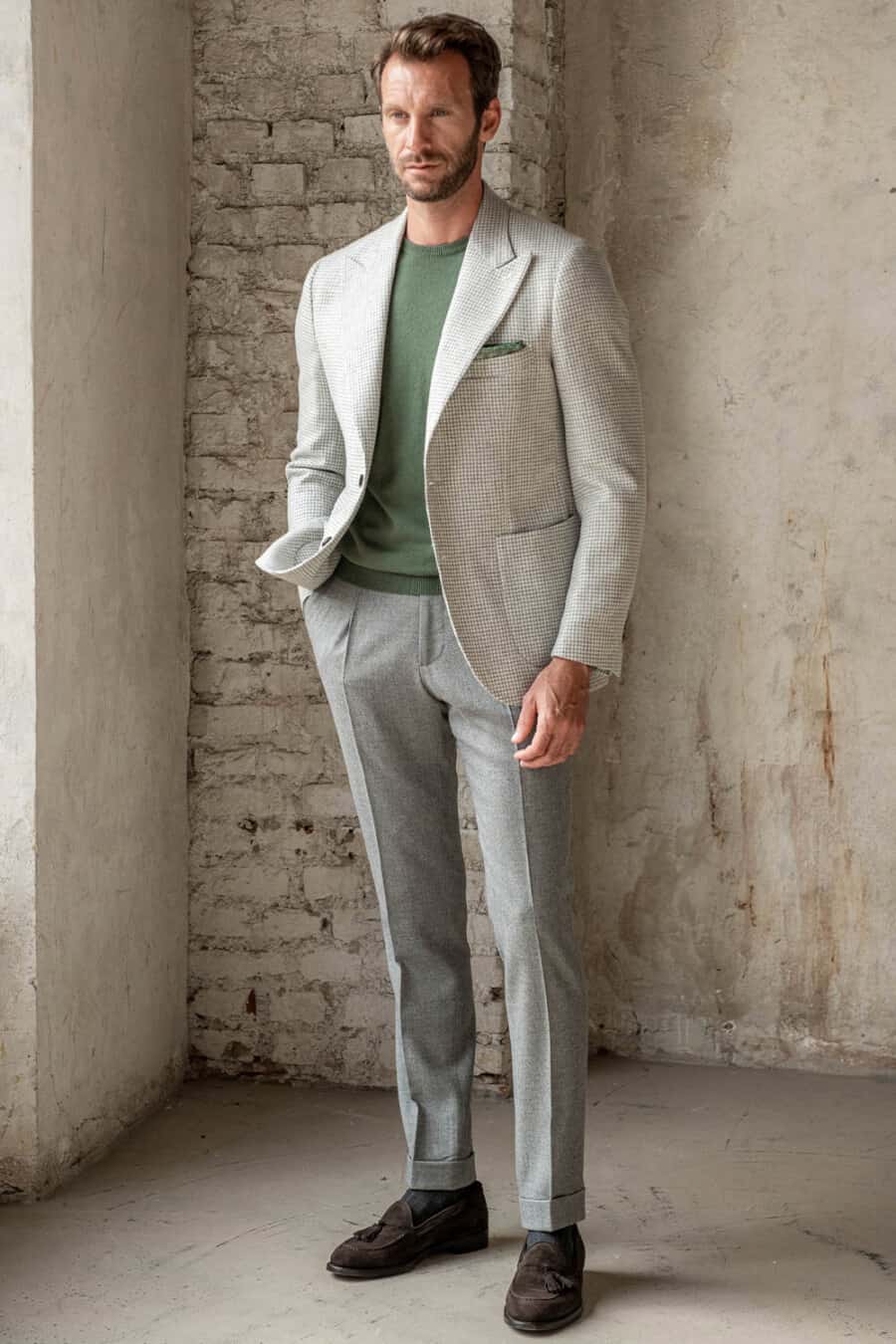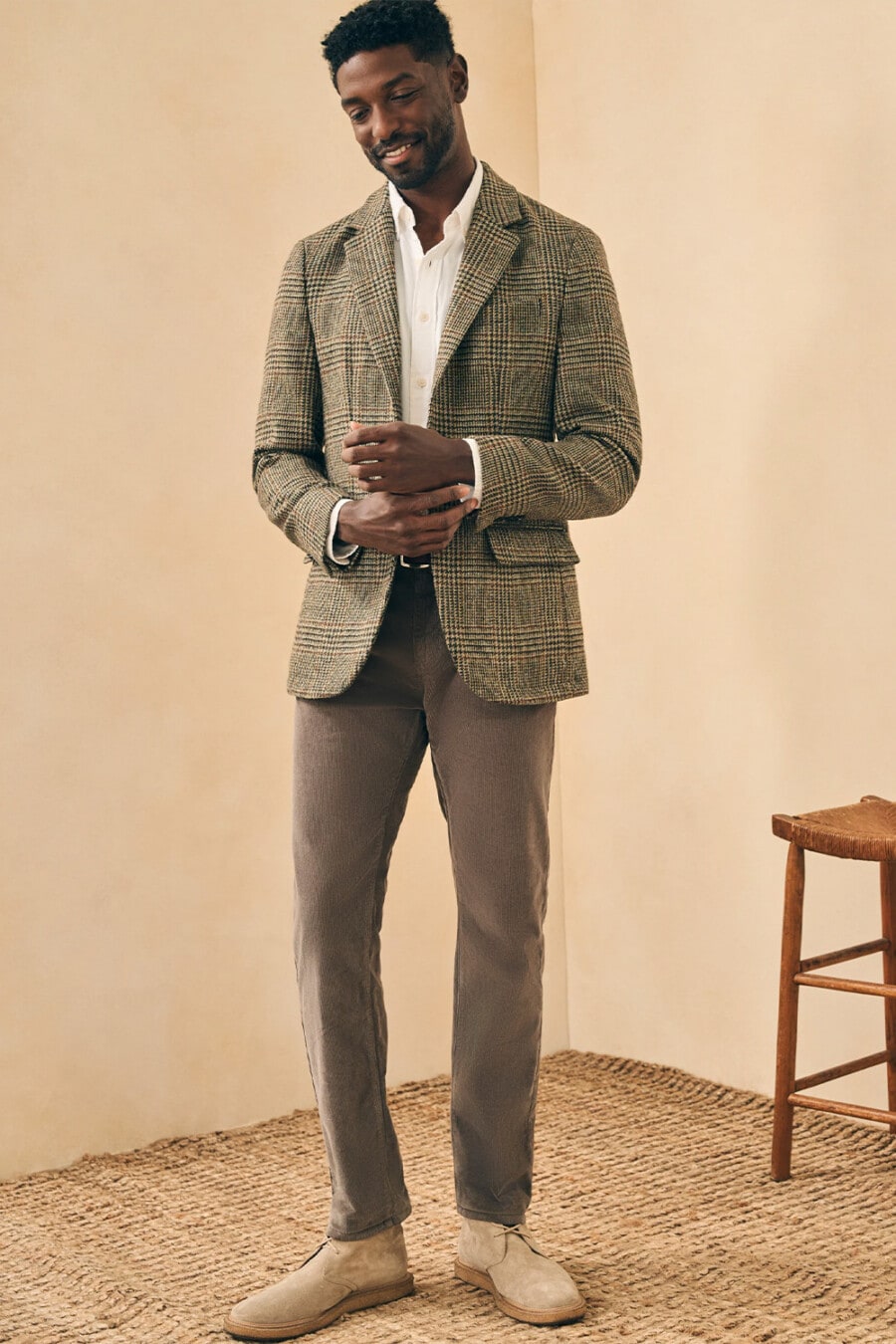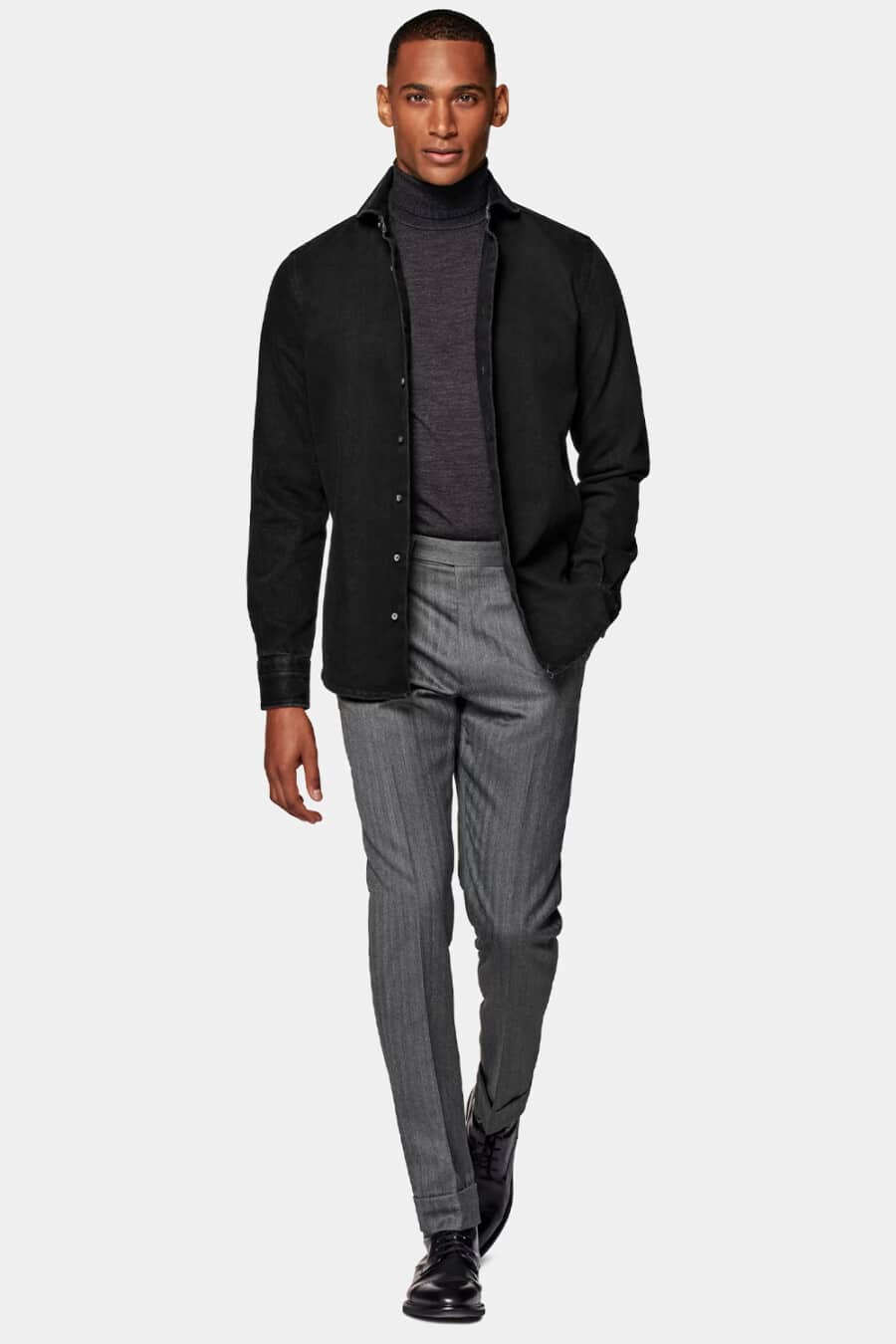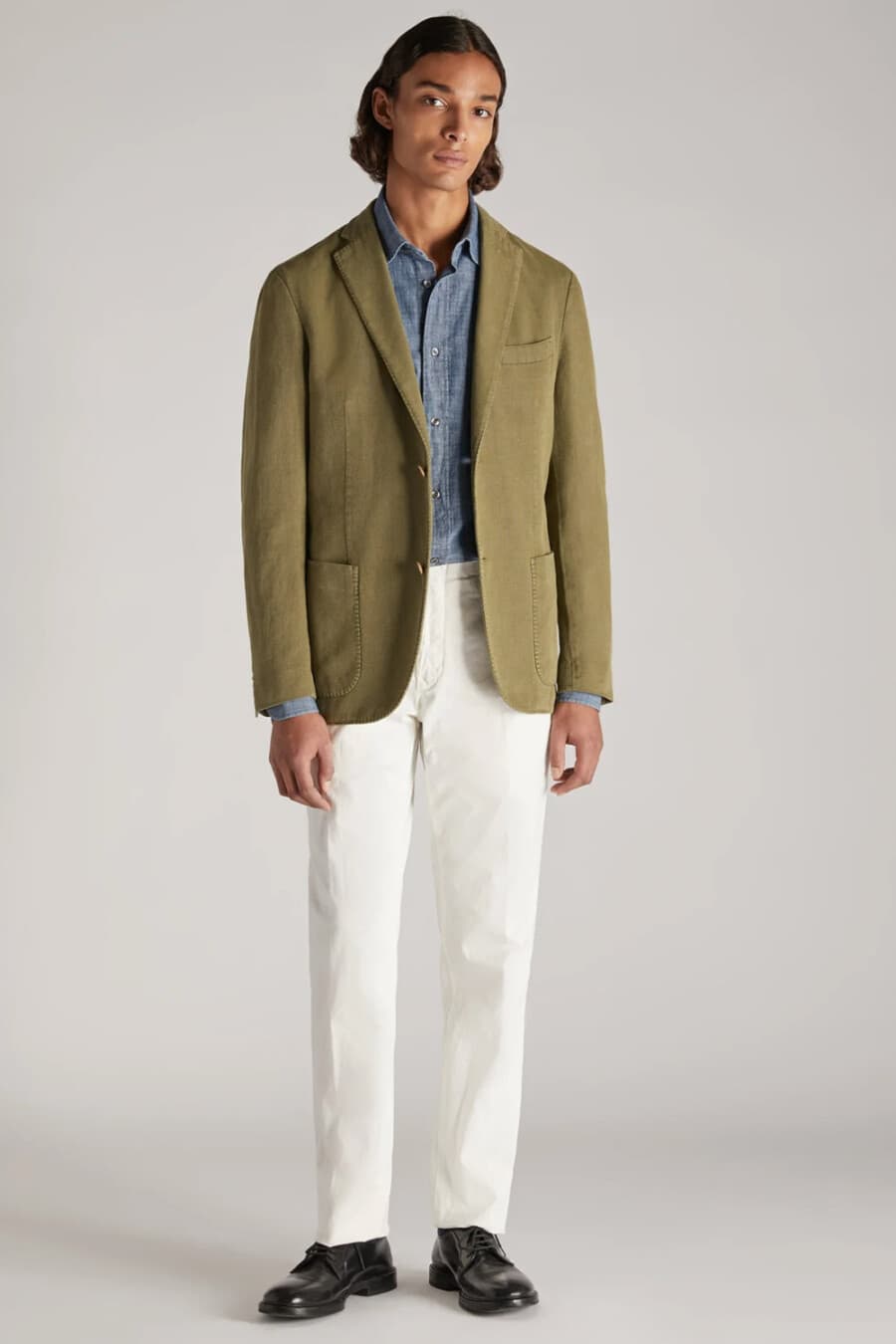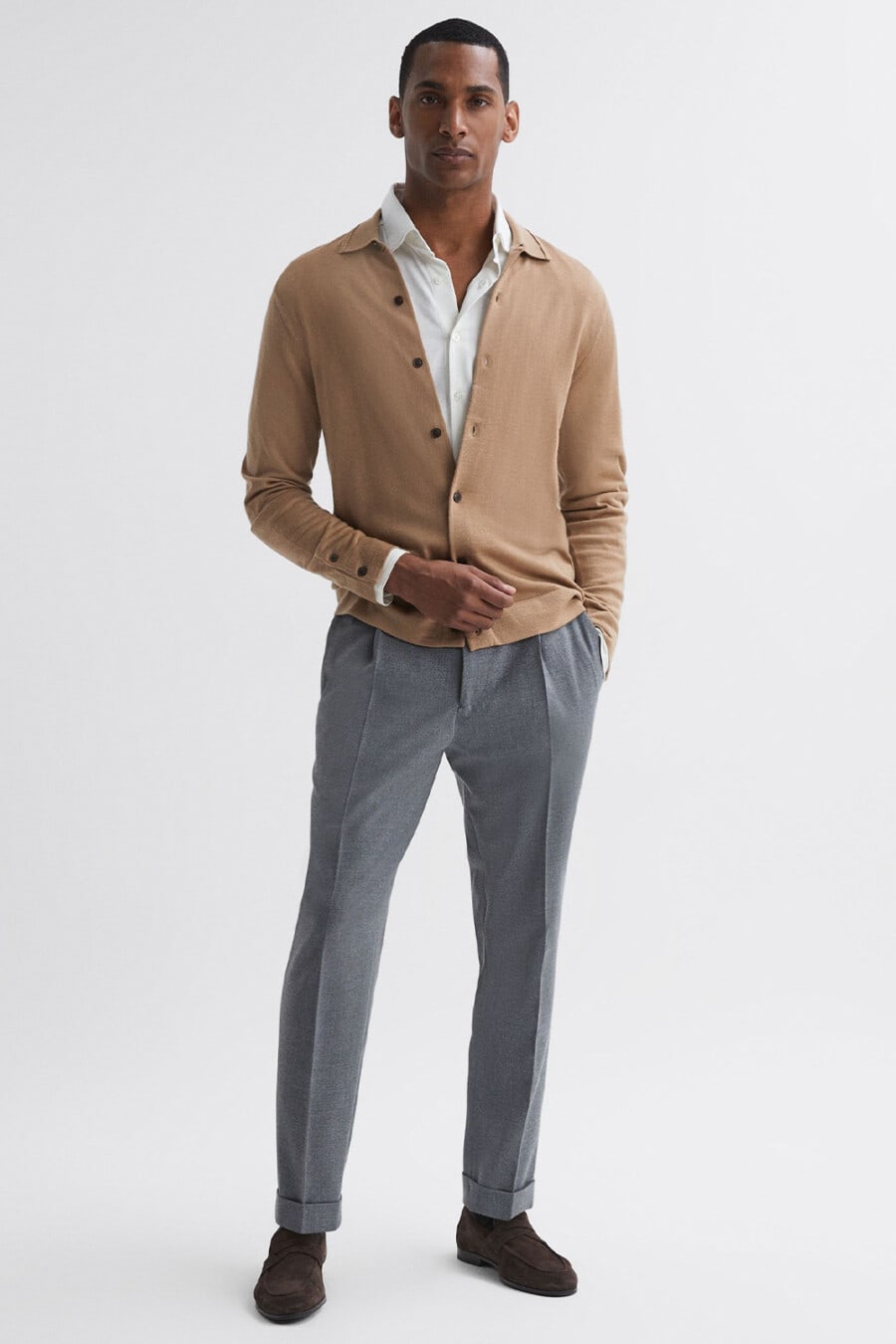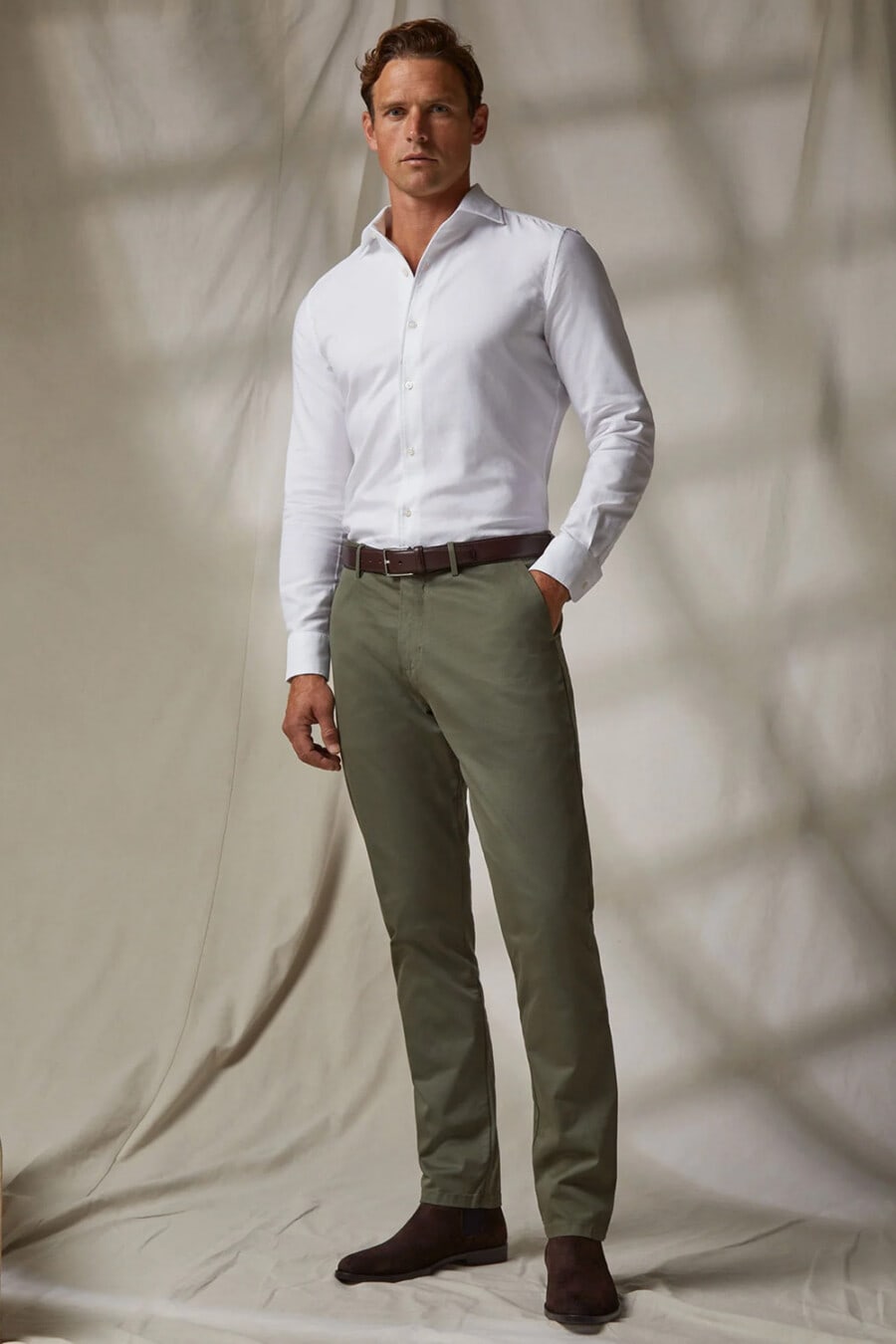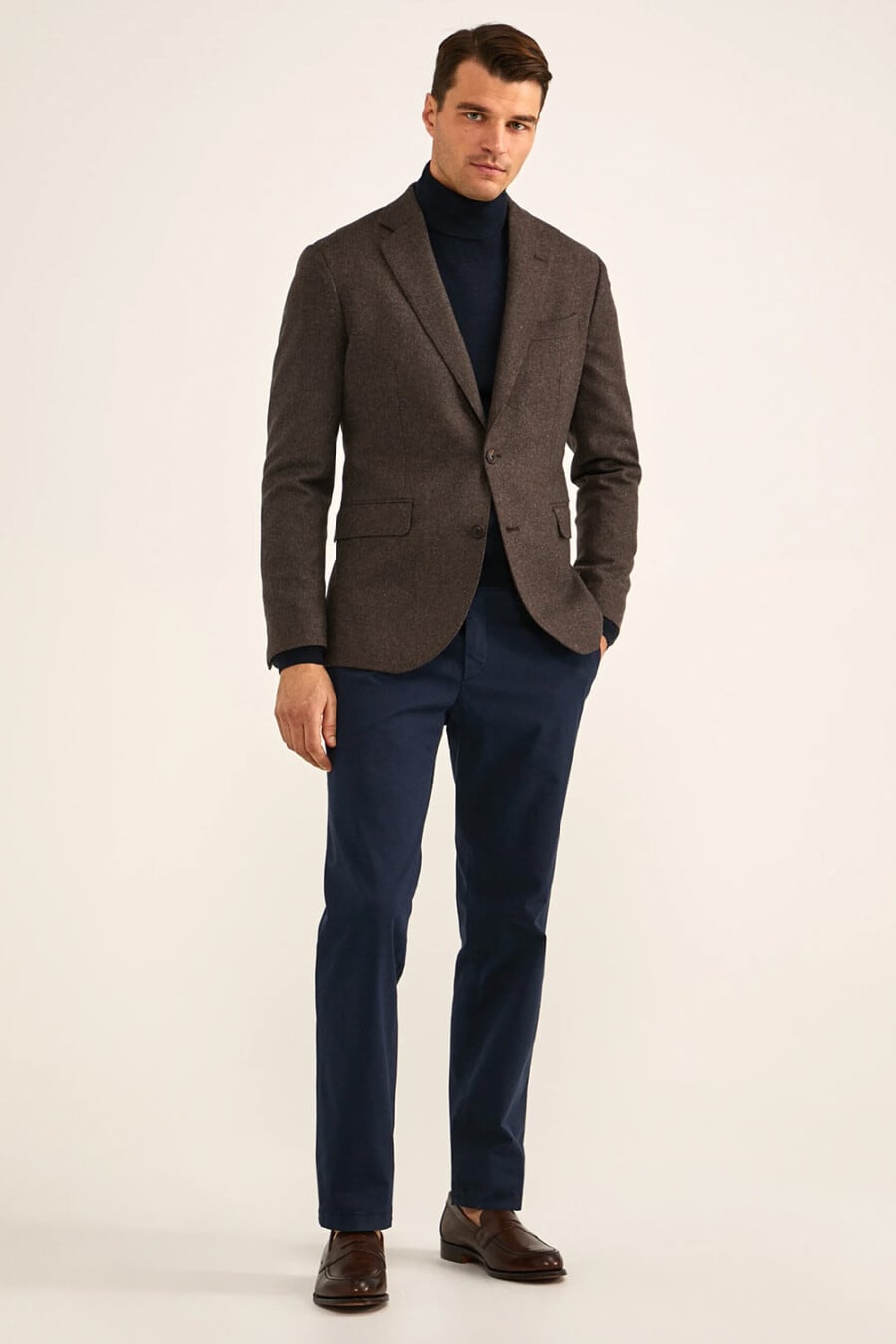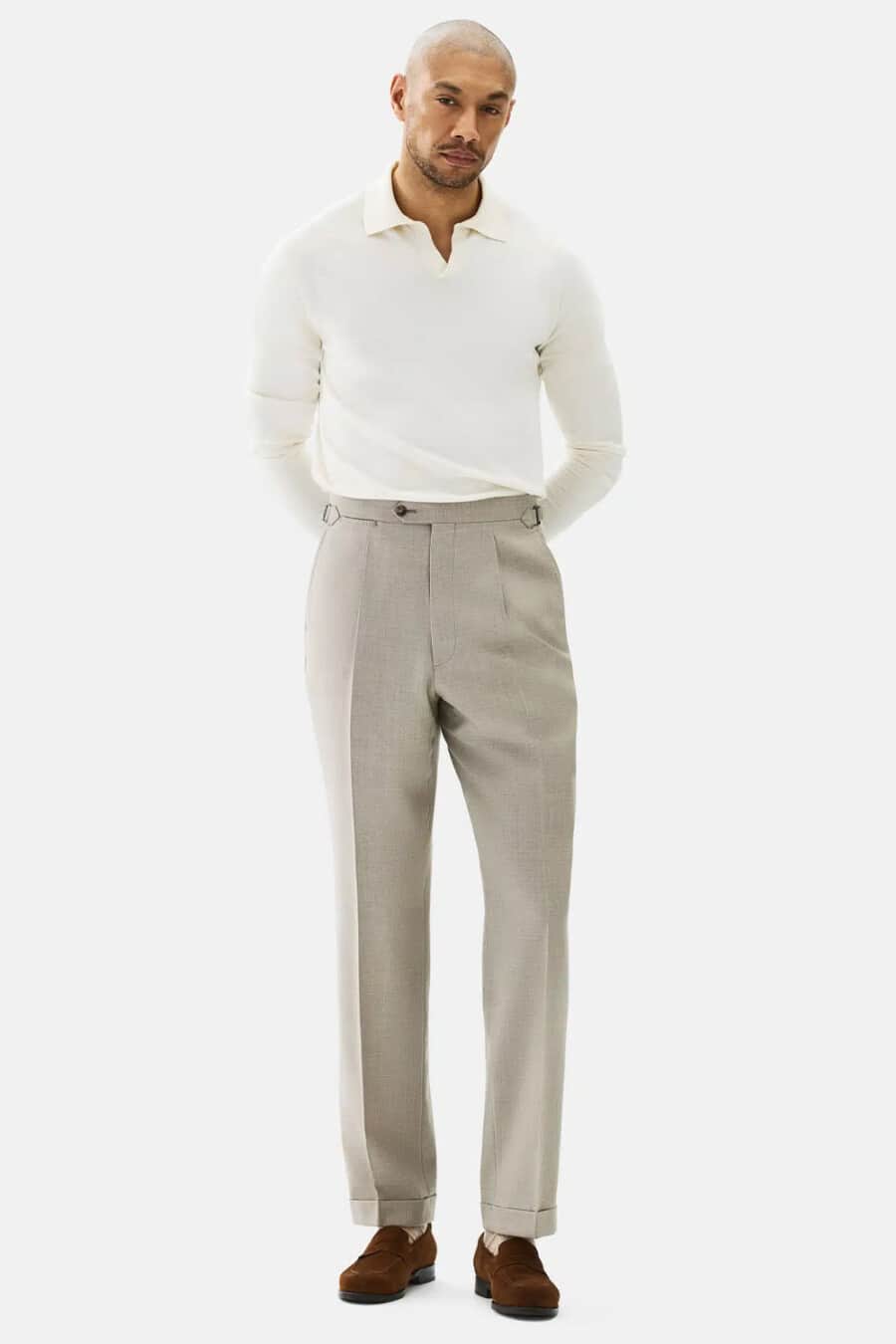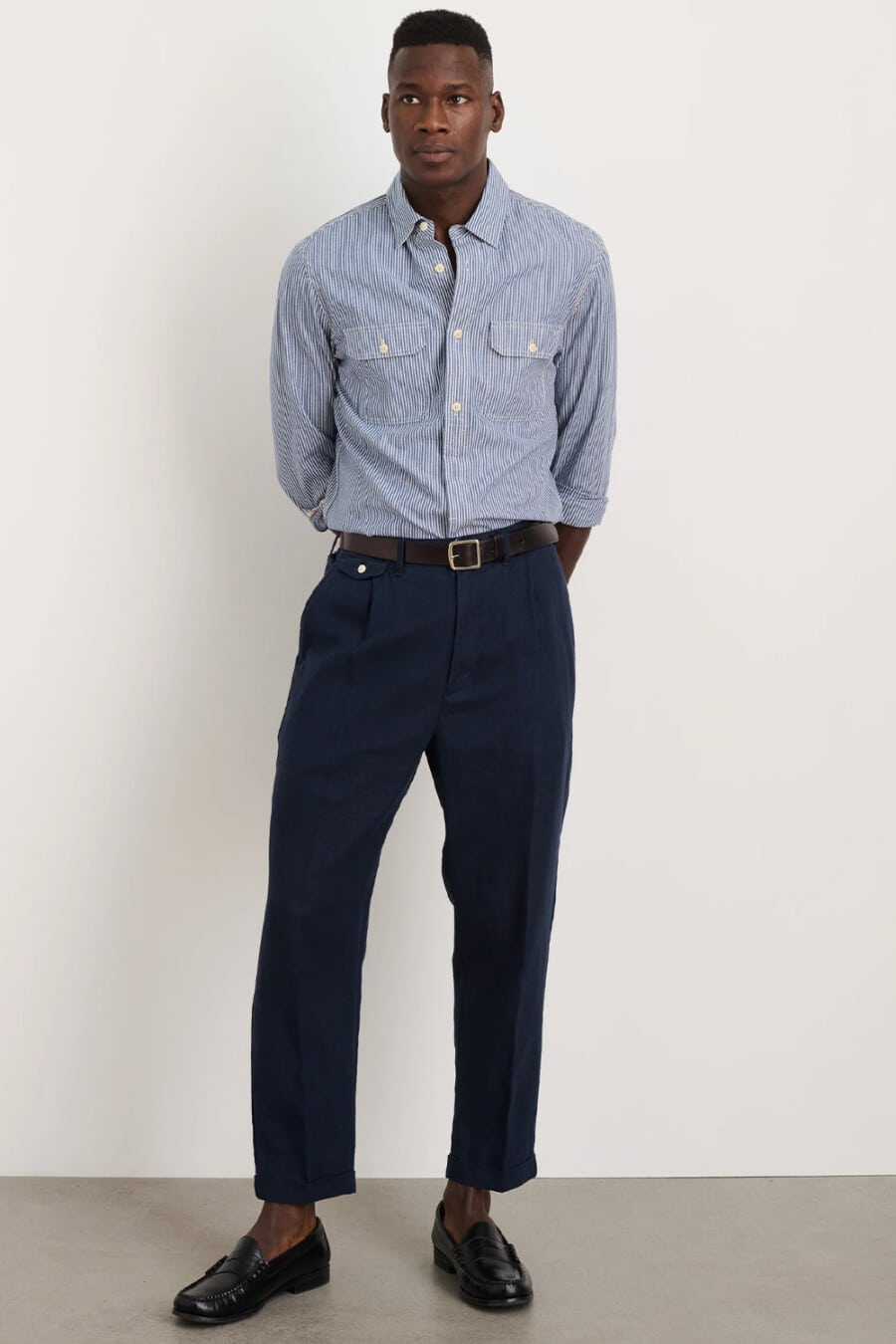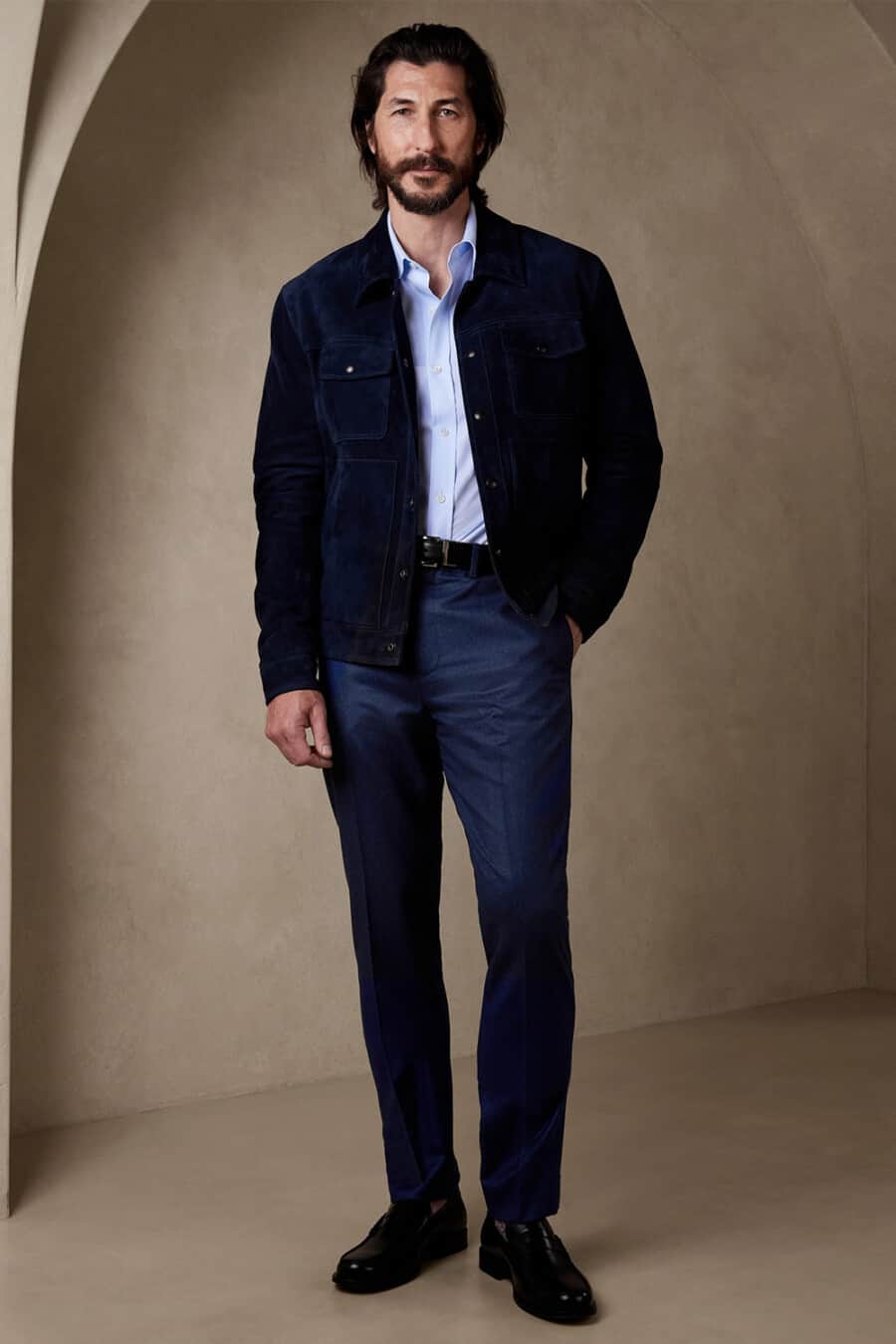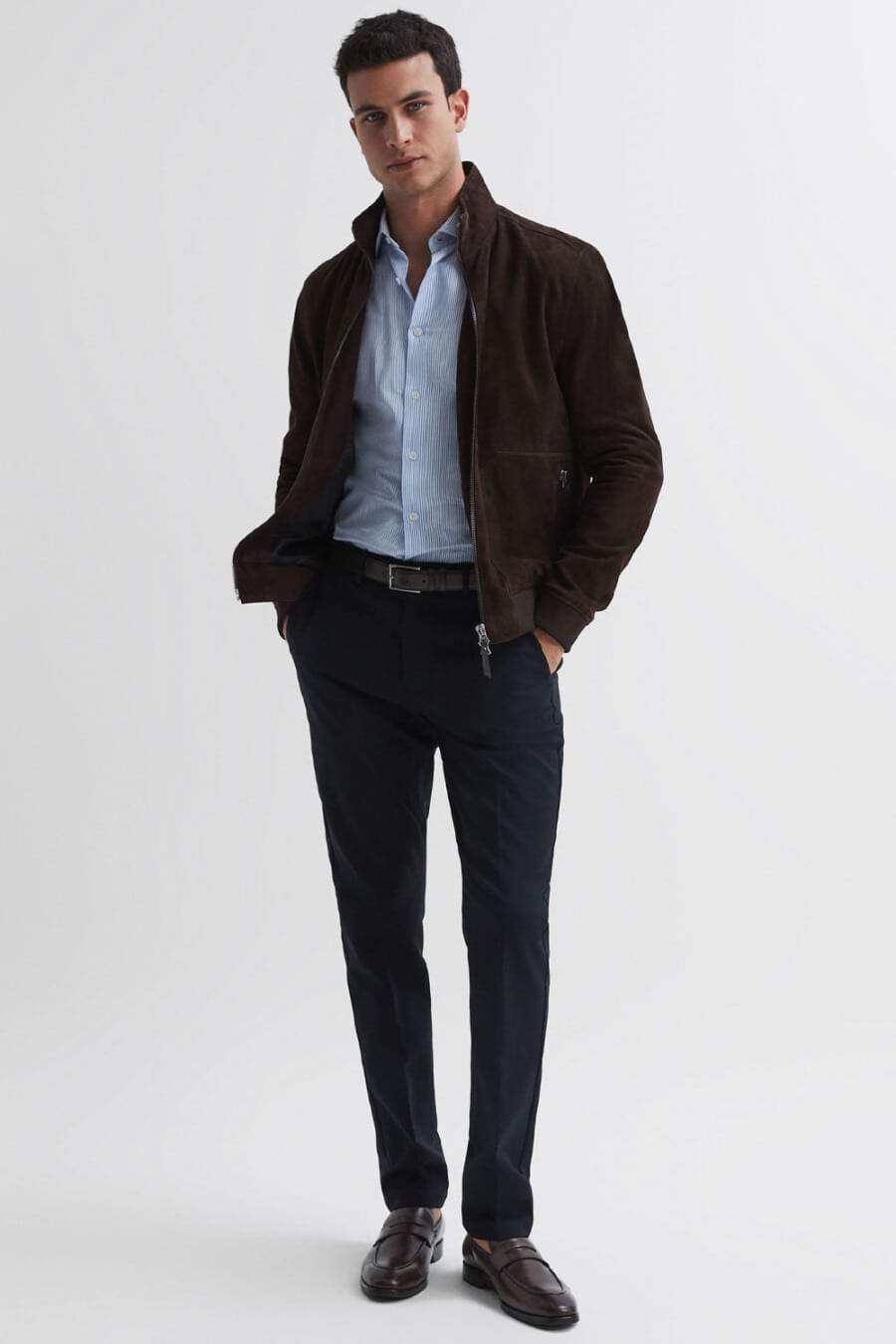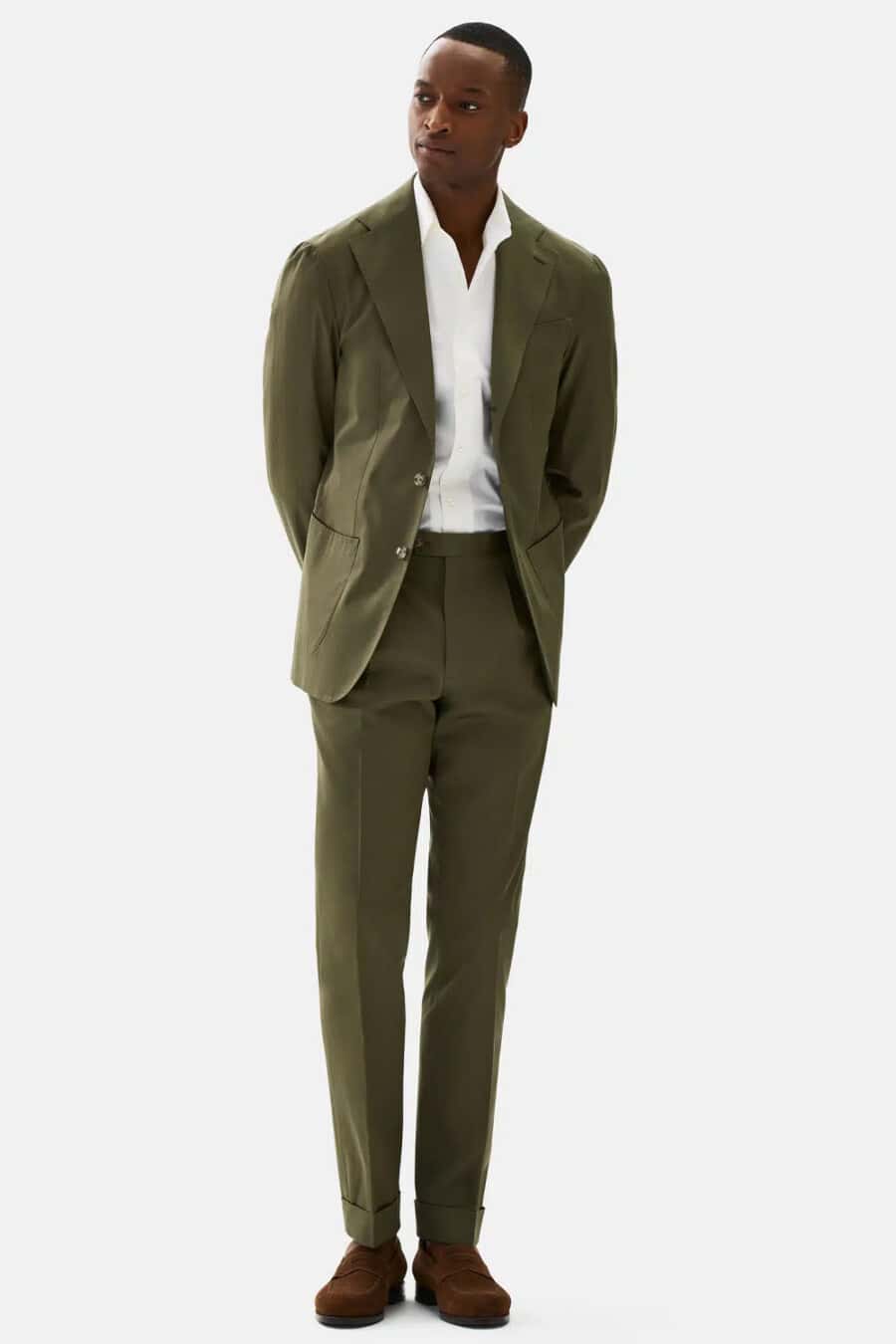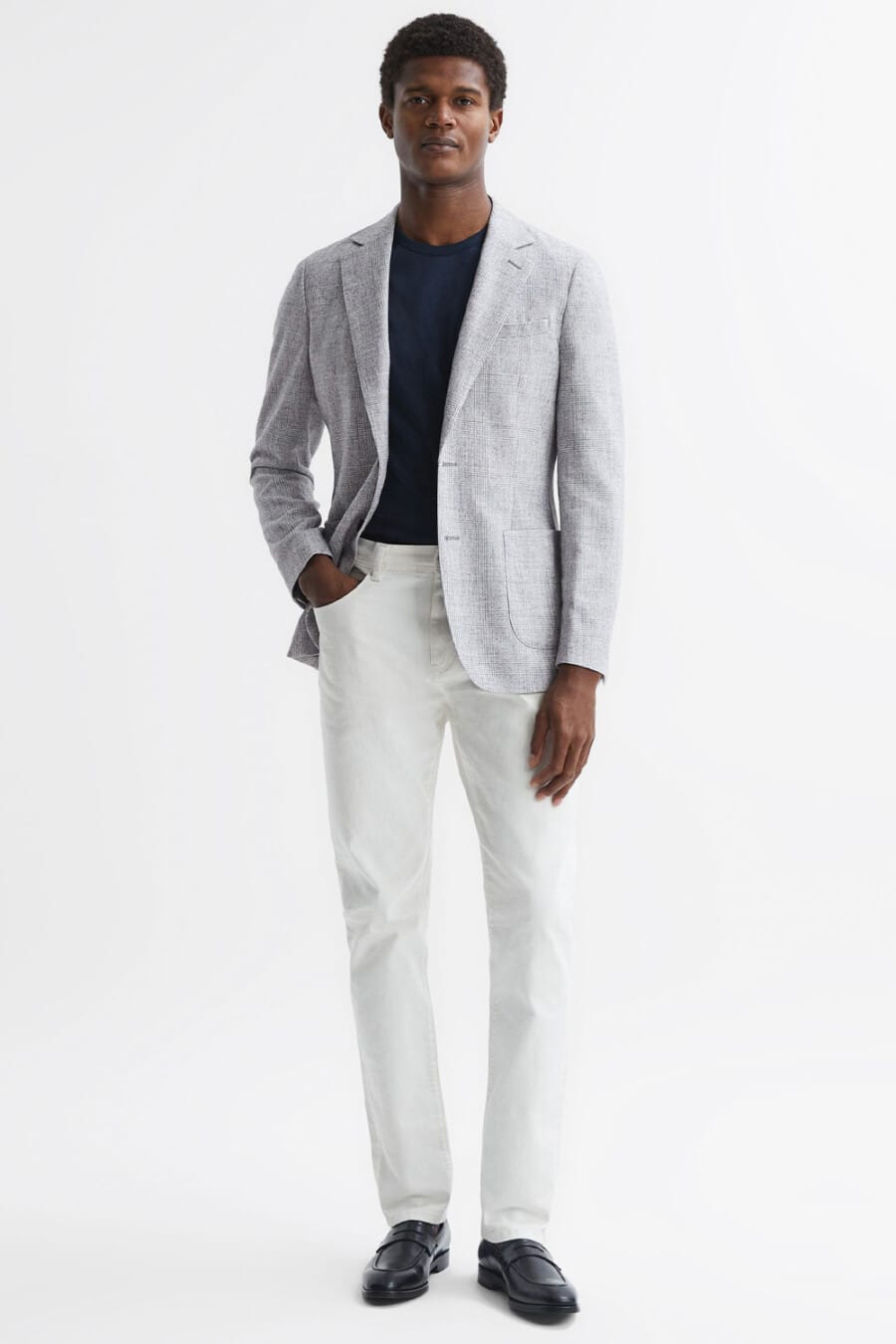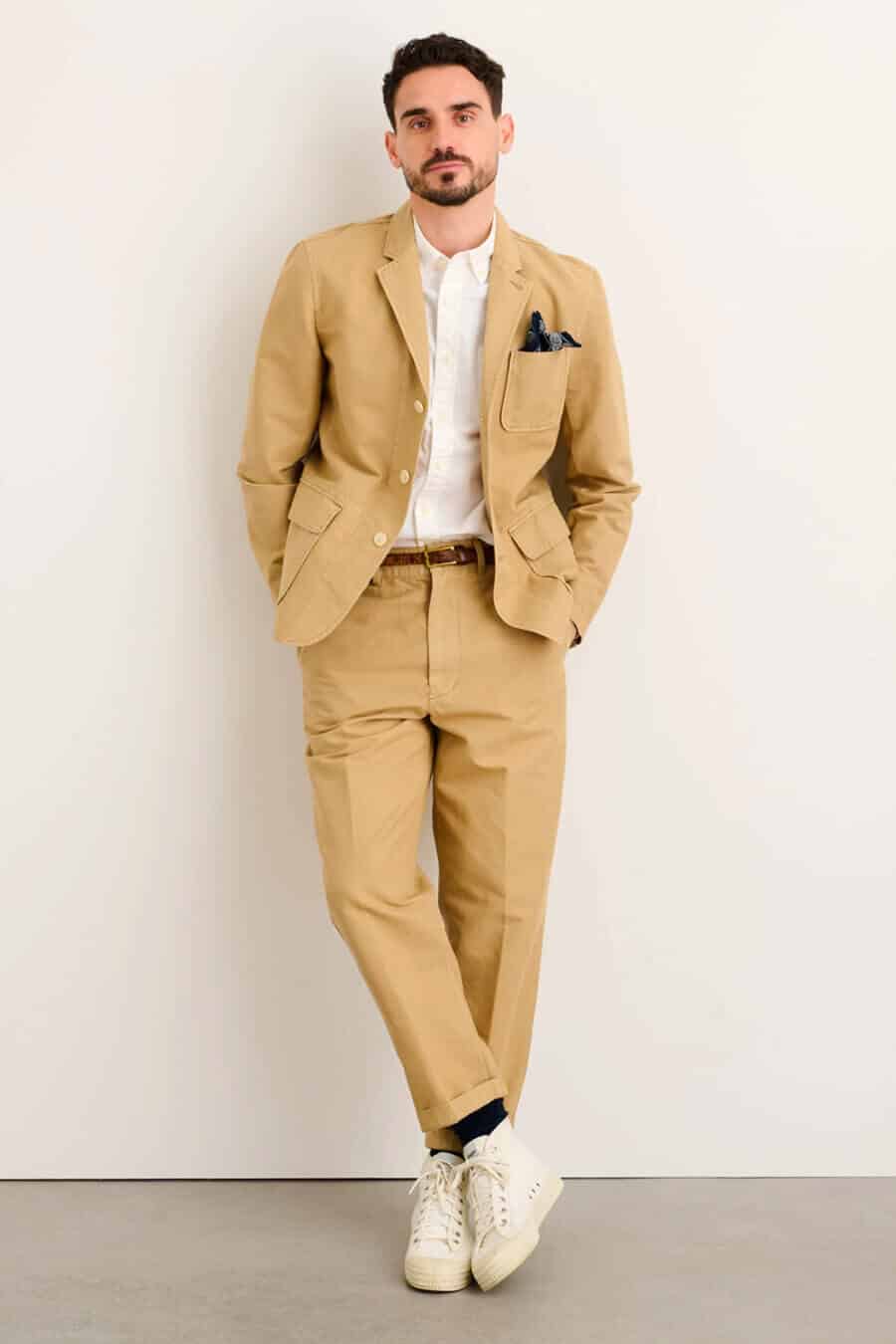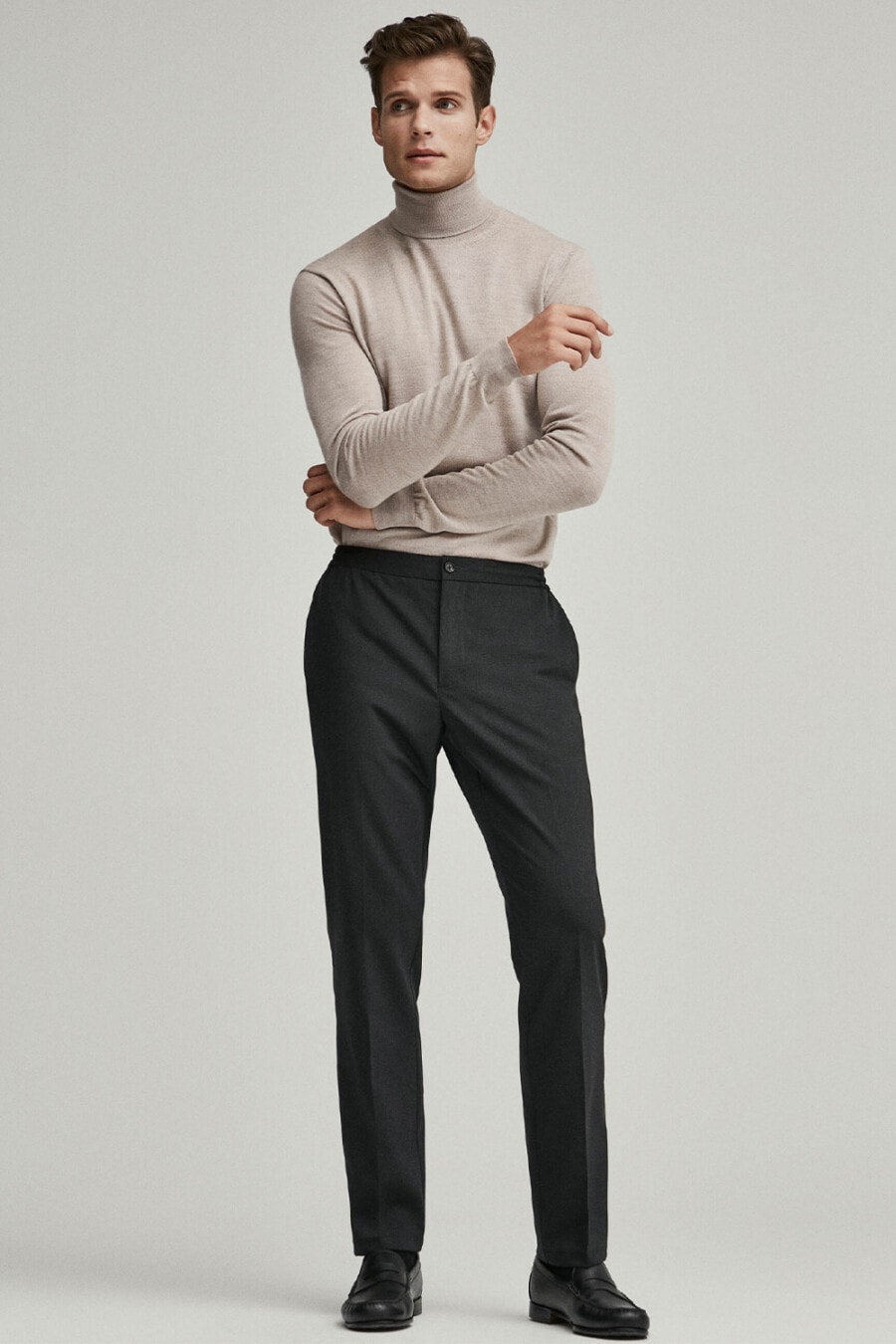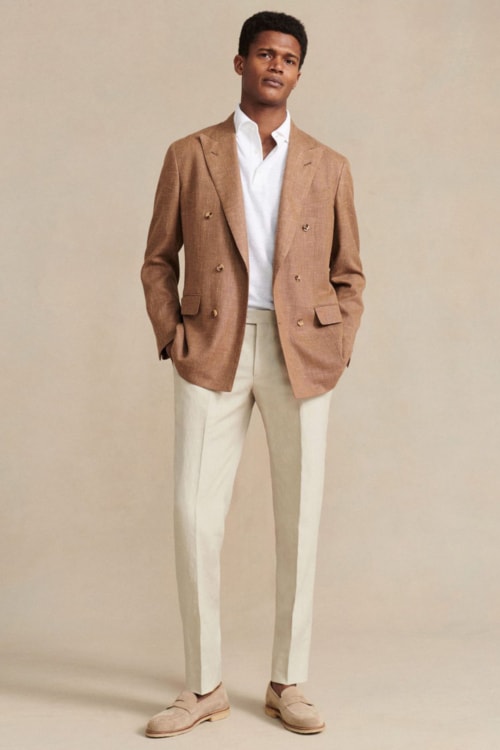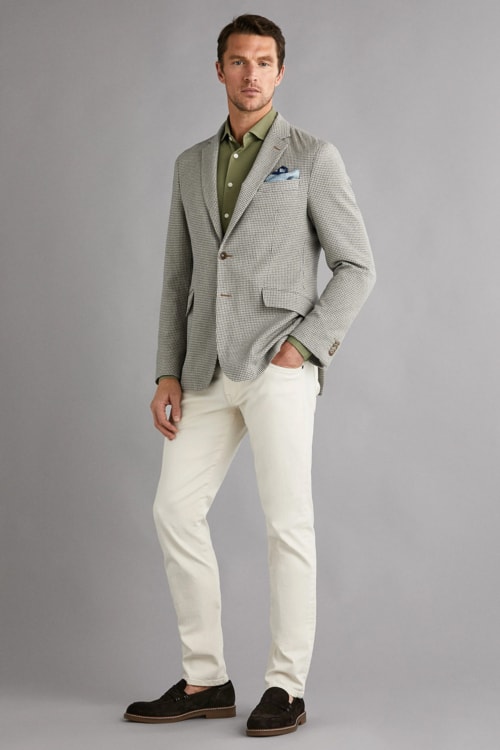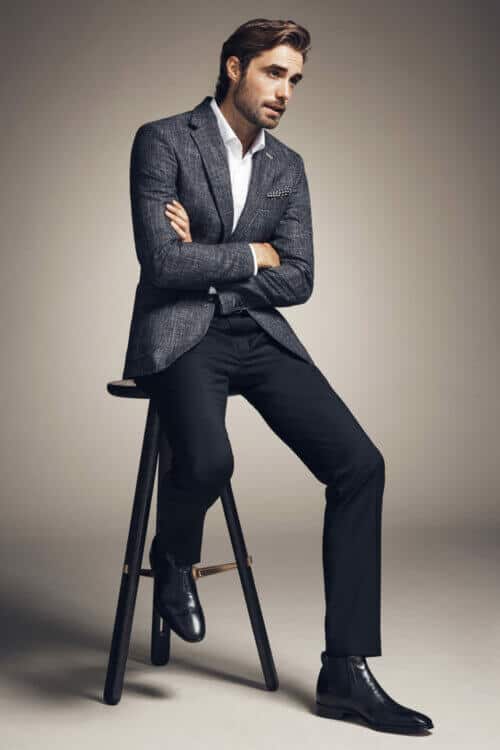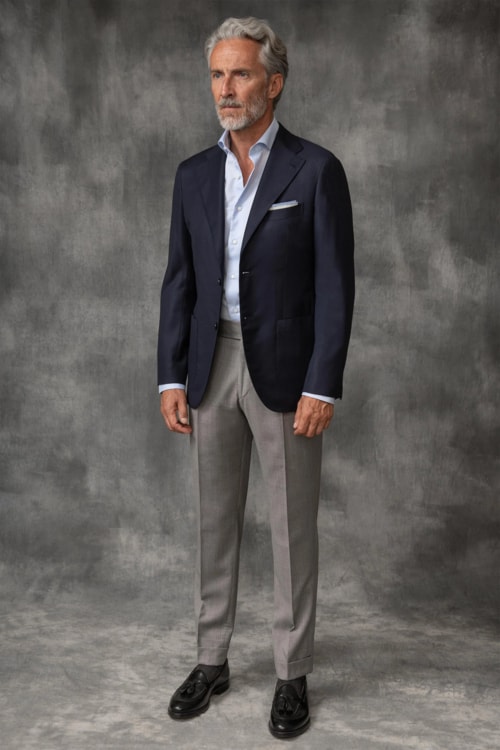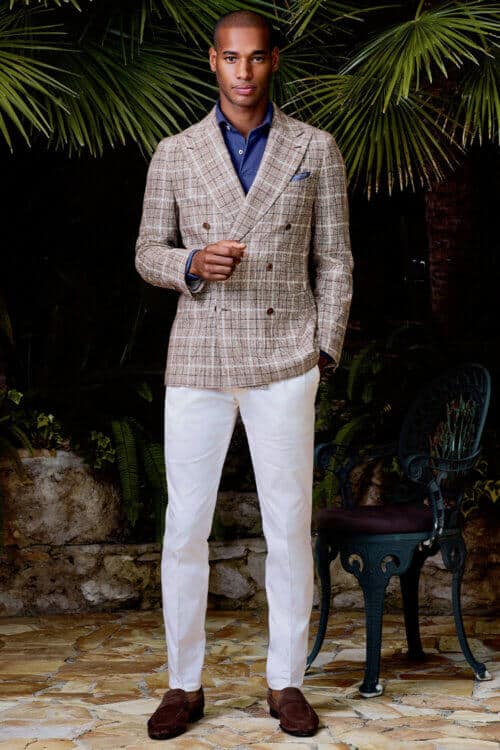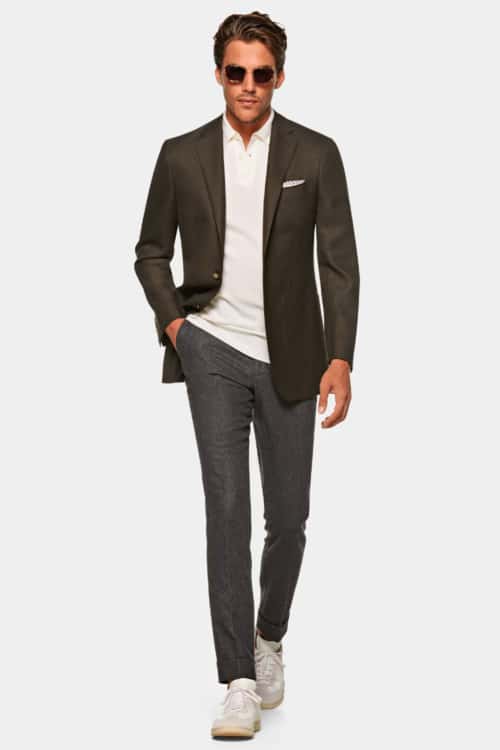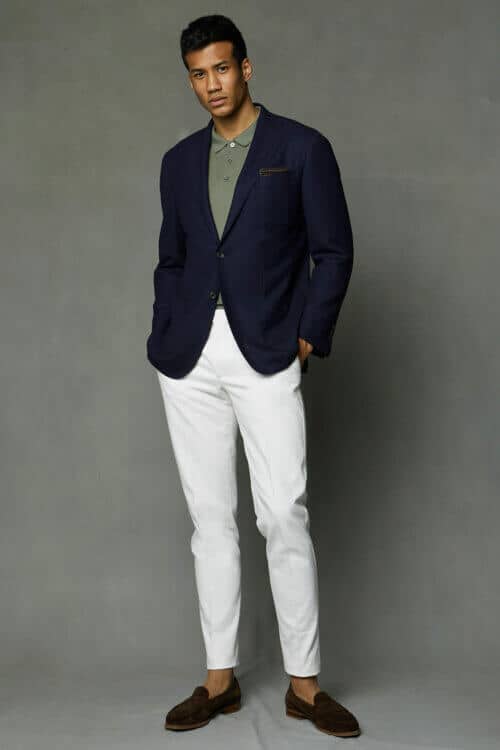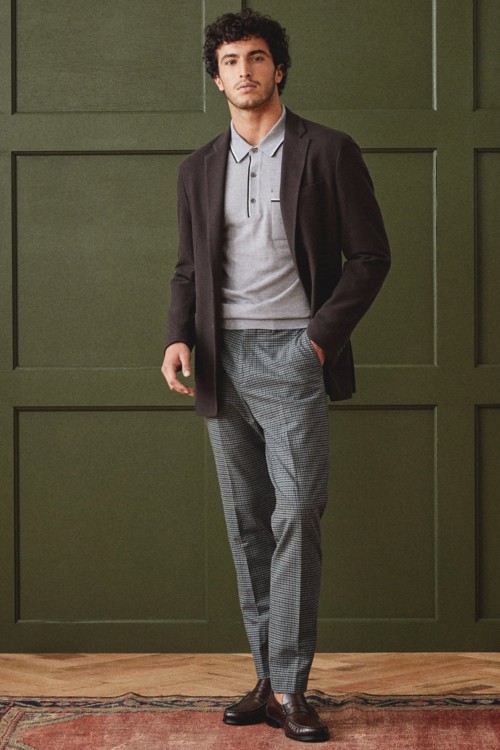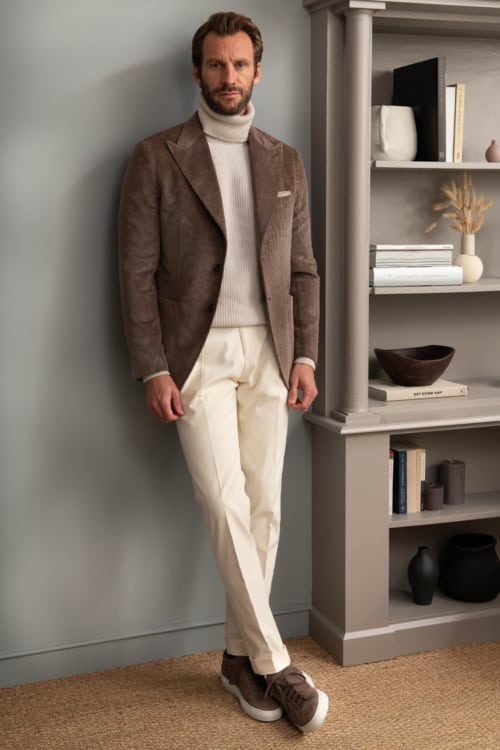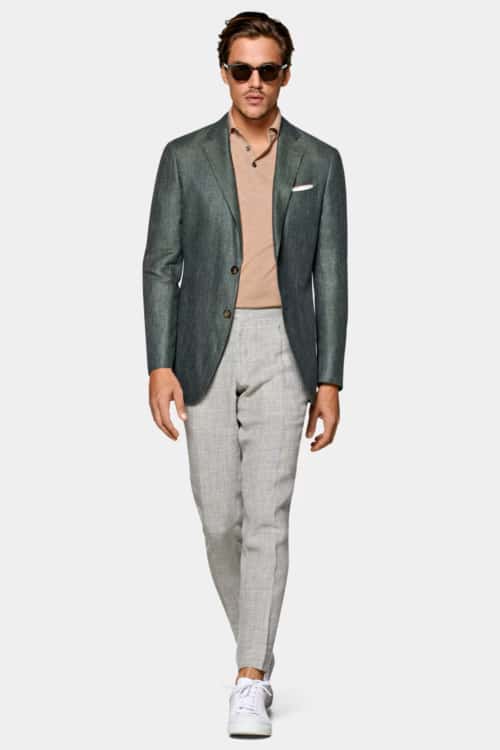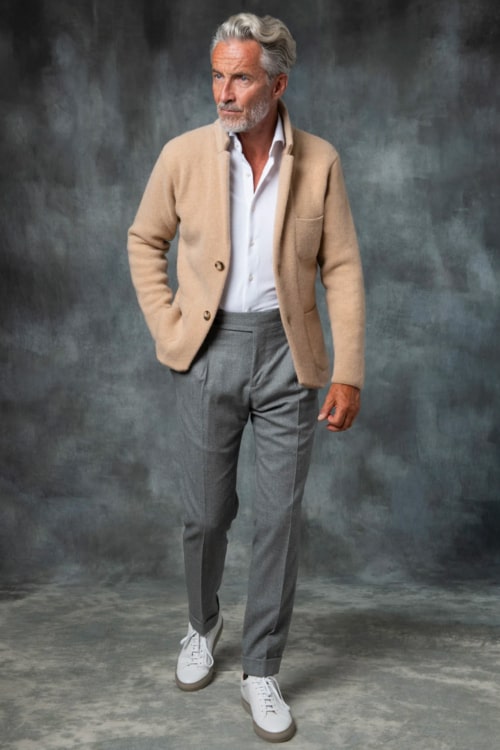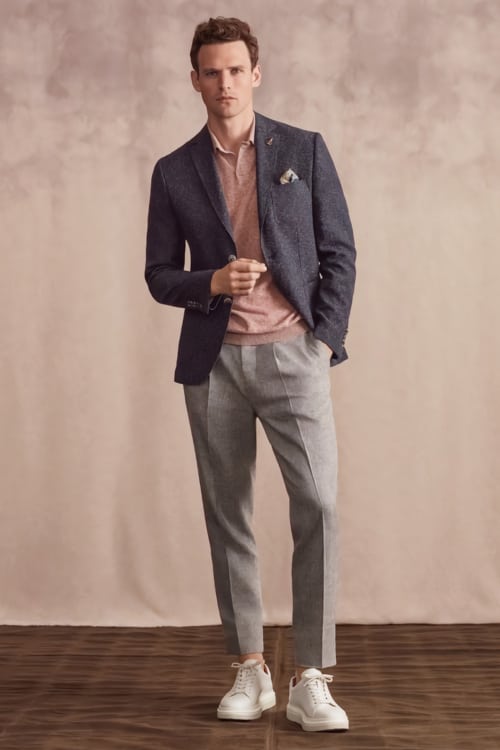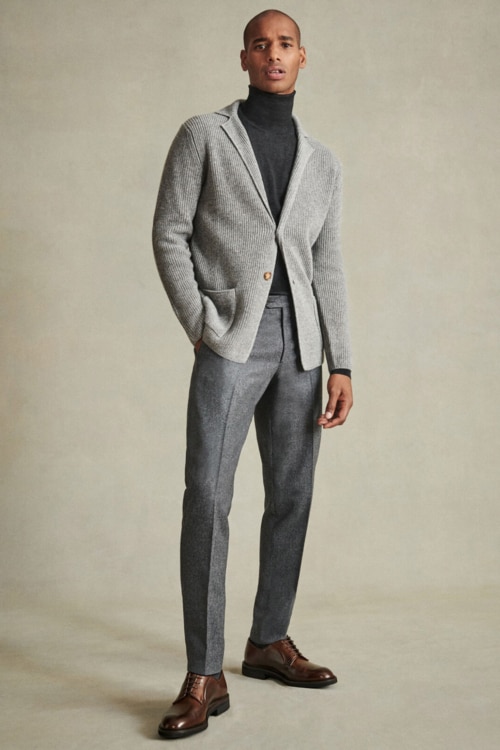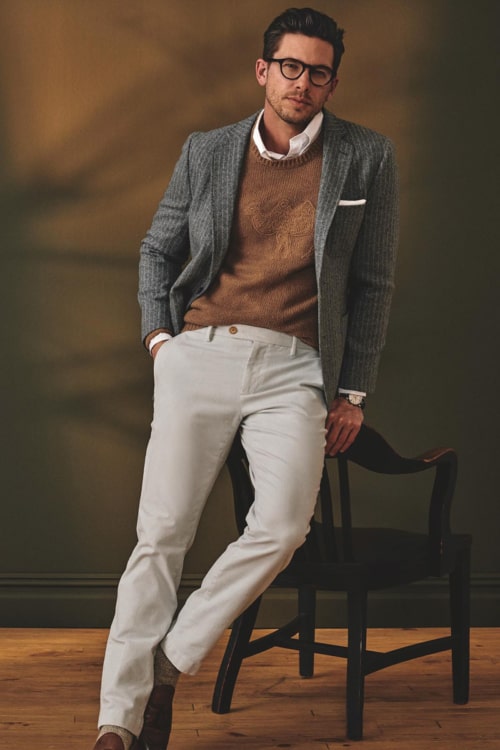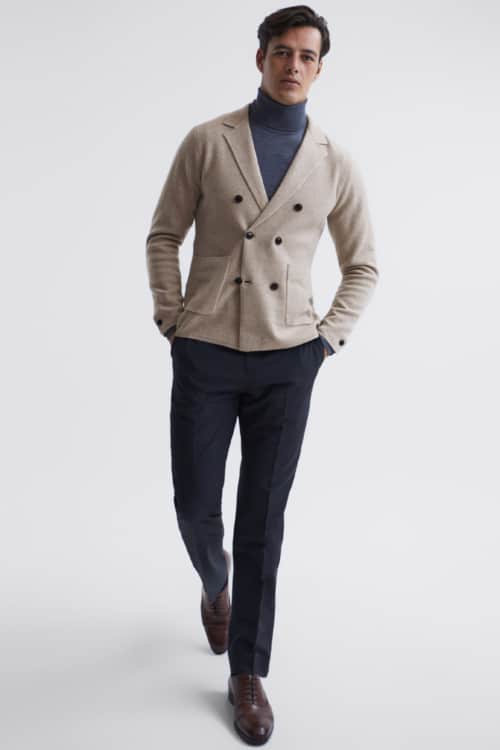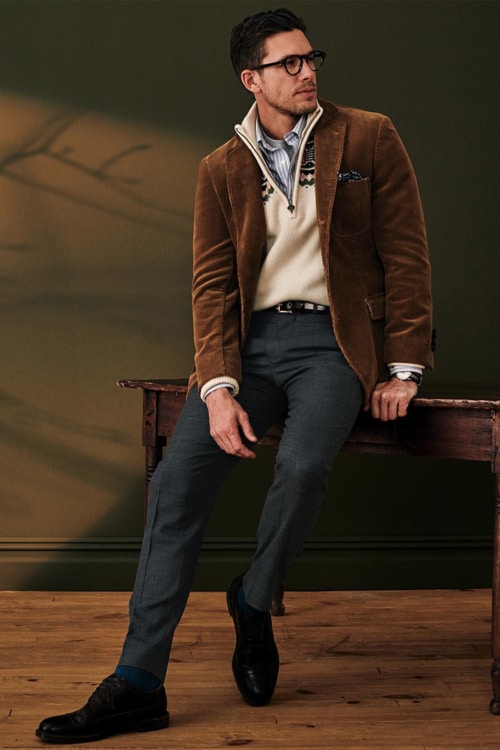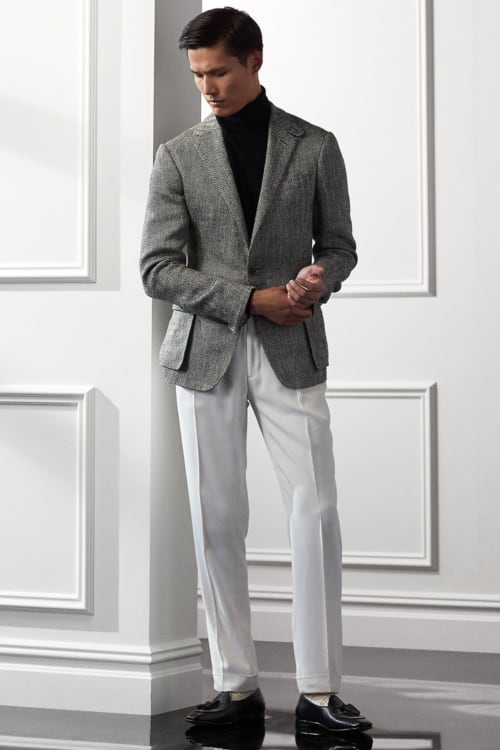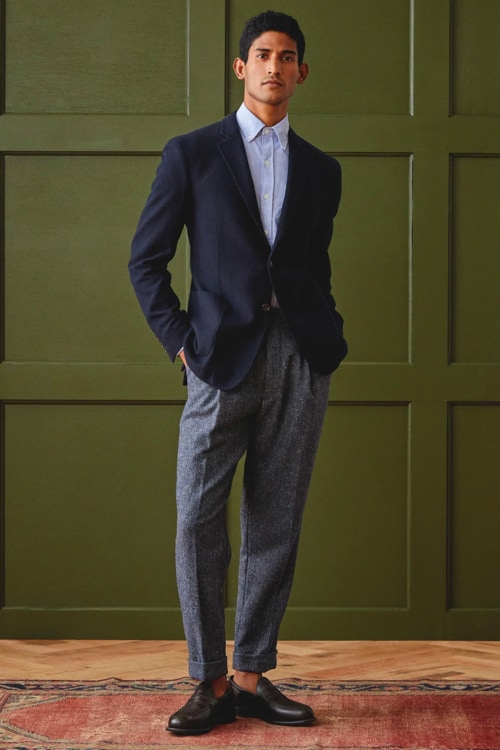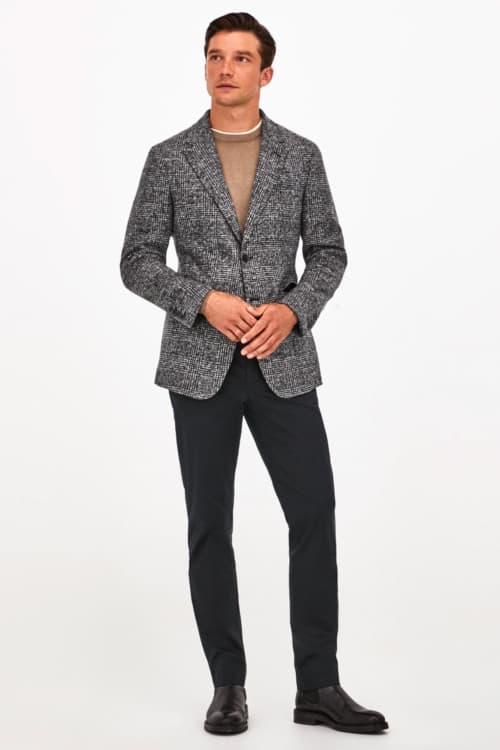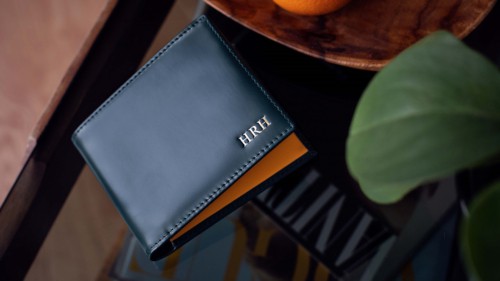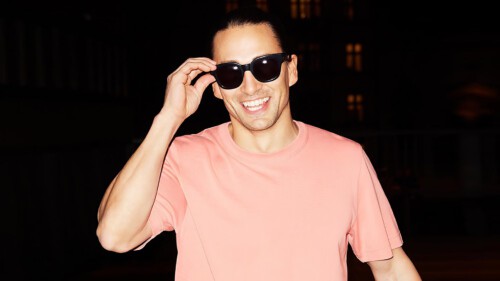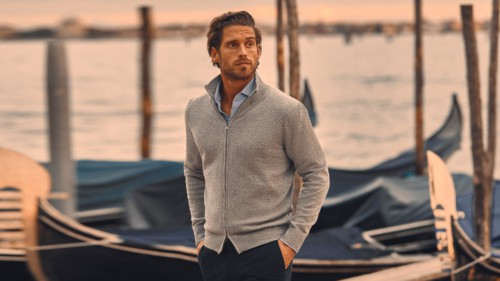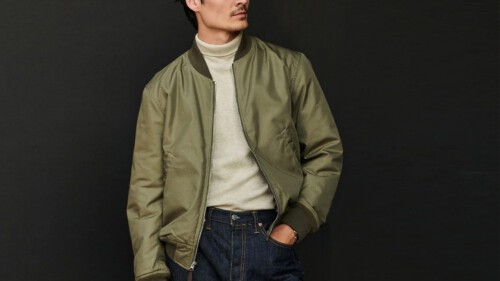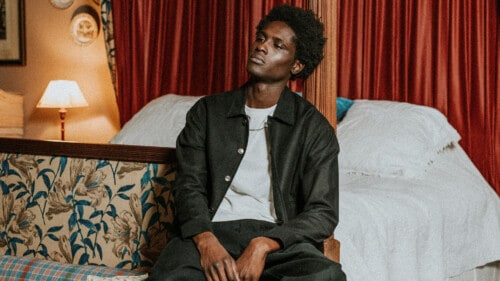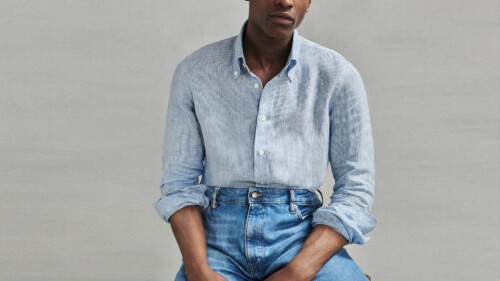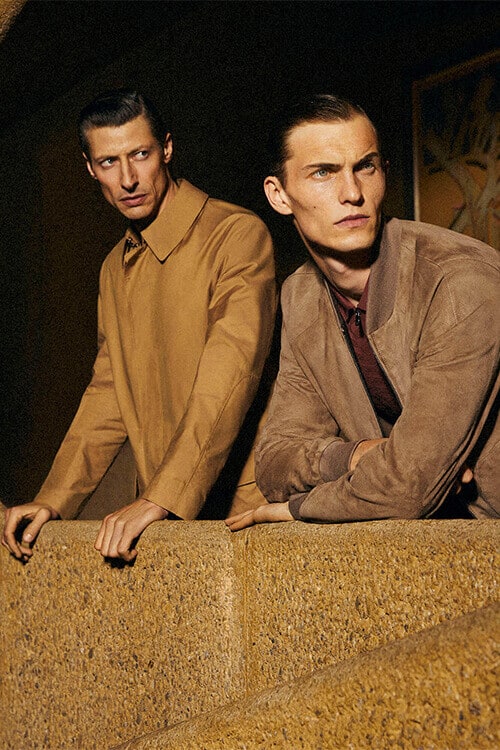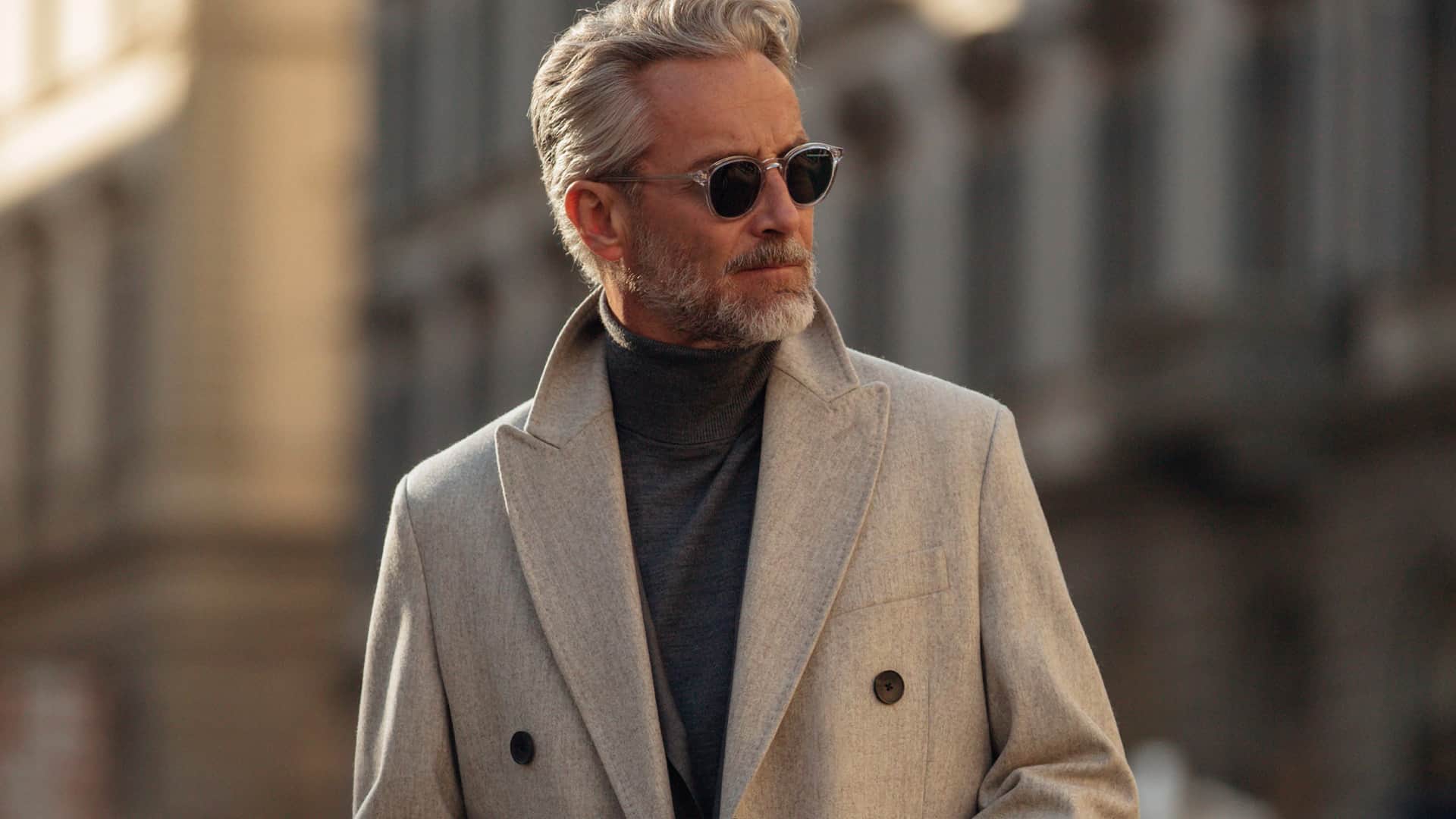
The Modern Man’s Business Casual Guide: 54 Outfits That Work
We show you how to inject some personality into menswear’s dullest (and confusing) dress code.
Imagine turning up to your office in a full lounge suit. Unless you work in corporate finance or on Savile Row itself, chances are you’re going to raise a few eyebrows. Why? Because here in the 21st century, the suit’s reign as the go-to workplace uniform for men is well and truly over.
Toppled by the rise of powerful tech billionaires who rock up to their Silicon Valley offices in T-shirts and jeans, along with the exponential growth of creative industries, tailoring has given way to casualwear. It’s good news in terms of comfort and wardrobe options, but what happens when you need to look presentable for an important meeting or an interview? That’s where business casual comes to the rescue.
Sartorially speaking, it’s hard to imagine a more self-contradictory concept than ‘business casual’. On one side, it’s pinstripe suits, Oxford wingtips and neckties, while on the other, it’s T-shirts, jeans and sneakers. How can these two wildly different ways of dressing merge to form a single dress code?
Traditionally, the answer to that question has been a boring one: blazer, chinos, shirt and leather shoes. But as menswear evolves and dress codes continue to diversify, there are now more options than ever when it comes to approaching men’s business casual attire.
What is men’s business casual dress?
Much like its cousin, smart casual, business casual is notoriously ambiguous. There’s no clear-cut definition, and even those rules that do exist tend to vary from country to country. Broadly speaking, the term refers to sharp ‘casualwear’ (in the traditional sense of the term, i.e. sports coats and chinos as opposed to suits, etc), almost always incorporating a shirt, presentable leather shoes, and often without a necktie. The color palette tends to be muted, consisting mainly of darker hues such as navy and various shades of grey.
In colder weather, knitwear, such as a fine-gauge crew-neck sweater or quarter-zip, could be worn as a mid-layer over a shirt and under a blazer, while smart outerwear, such as a mac, wool overcoat or trench coat, would be acceptable as a top layer.
Because business casual has no clear definition, it’s open to interpretation to an extent. This is particularly true as dress codes continue to loosen up across the board. As long as colors are conservative, garments are neat and smart, and the overall look is presentable and tidy, then there’s a degree of creative freedom when it comes to piecing outfits together.
The evolution of the business casual dress code
It’s not entirely clear when or where business casual first arose as a dress code, but the widespread acceptance of it in many workplaces began during the 90s. Casual Fridays, also known as ‘dress-down Fridays’, became a bit of a workplace trend, which helped office dress codes to loosen up from their former stuffiness.
As suits became less common in the workplace, business casual became the new standard for many companies. Strict rules about workplace attire were largely ditched and replaced with vague guidelines about the types of garments employees were expected to wear. This opened up a whole new world of workplace wardrobe possibilities for men – there were now options outside of a suit, shirt and shoes.
Today, business casual is still evolving. Dress codes in general have loosened up a lot over the last decade or two, which means the scope of what counts as appropriate business casual attire is much broader now. See below for some of the key pieces.
Men’s business casual dressing tips
Keep colors muted
Generally speaking, the office is not a place for neon hues, statement prints and wild patterns. To keep things professional, the best course is to keep the color palette simple and subdued.
Neutrals are the best bet and remember: the darker the color, the smarter the garment.
Give both words equal attention
Don’t get too bogged down in either the business or the casual side of things. Instead, look at the dress code as a whole. You want to focus on achieving a good balance between the two, which means selecting pieces that don’t lean too far in either direction.
Take the rough with the smooth
Working with a restricted color palette doesn’t have to mean putting together boring outfits. Color isn’t your only weapon in the fight against drabness. In fact, utilizing different textures can be every bit as effective when it comes to adding a bit of personality to your business casual looks.
Fabrics like wool, corduroy and pique cotton can really bring outfits to life, helping to create depth and focal points, even when the colors are conservative.
Fit is everything
This is a rule every man should live by, but it goes double in professional settings. You can spend as much as you like crafting the perfect workplace wardrobe, but if the fits are sloppy, it’ll all have been for nothing.
Find pieces that fit you perfectly and stick to them. Know your body type, what works and what doesn’t, and if you’re unsure, find a good local tailor and let them do the hard work for you.
Think about the smart casual spectrum
Imagine a spectrum with casual at one end and smart at the other. Business casual is effectively right of center, but that doesn’t necessarily mean you have to stick religiously to garments from that exact spot on the spectrum too.
The key word here is balance. It’s fine to mix in smarter pieces and more casual pieces as long as they balance one another out. Want to wear a pair of leather sneakers? That’s all good but offset the casualness of the footwear by opting for a smarter trouser or a blazer.
Accessorise accordingly
Don’t let something as simple as a bag or a watch ruin your carefully crafted outfit. Pick accessories that complement the business casual aesthetic. That means a big no to sporty backpacks, but a resounding yes to luxury leather luggage.
Err on the side of smart where these extra bits and pieces are concerned and you can’t go far wrong.
Don’t rely on chinos
It’s an easy trap to fall into, but there’s more to business casual legwear than khaki pants. We’d encourage you to experiment with either darker colors or a different style of trouser entirely. Again, cotton or wool dress pants are a great alternative.
Business casual outfits for men
A V-neck approach
It’s funny to think that you couldn’t pay people to wear a V-neck up until a few years ago, but fashion being fashion, the once-maligned silhouette is now firmly back on the sartorial radar. On the runways, it has been reincarnated in the form of huge plunging Vs with intricate cables, but in reality, the V-neck jumper has once again found its home in the realm of business casual.
This look – a bold green V-neck paired with navy suit trousers and a simple white shirt – shows you all you need to know. Even without a jacket, the ensemble is smart, with clean lines and a confident silhouette.
The preppy quarter-zip
From the collegiate corridors of 1950s Ivy League institutions, the quarter-zip sweater has deftly negated preppy style and sportswear, but it’s in its former guise that it best lends itself to the business casual dress code.
Worn over a simple shirt or polo, and teamed with tapered chinos or suit pants, the quarter-zip bestows upon your look an air of comfortable authority. Layer over a blazer for a modern twist on preppy style, or wear it beneath a gilet for a contemporary aesthetic.
Tonal separates
We’re big fans of tonal dressing for one simple reason: it’s difficult to get wrong. Why overcomplicate the act of getting dressed and looking good? This business casual outfit is the perfect example of tonal styling, incorporating a cream unstructured jacket with khaki chinos, a white tee and tan suede loafers.
There isn’t a meeting you can have where the attendees won’t be impressed by this assured ensemble.
Tailoring and denim
Sartorial purists squirm any time they hear tailoring and denim in the same sentence, but times have changed and everyone’s favorite workwear pants have grown up.
The fact is, jeans these days are so much better quality than they once were. Incorporating a high-end, tapered pair of raw denim jeans into your business casual rotation is a no-brainer.
Combine them with an unstructured blazer and shirt to keep the smart balance on the money.
Sophisticated separates
Separates are the go-to failsafe option when thinking about business casual. You get all the benefits of the tailored jacket without the uniformity of the suit, plus you get to show a little personality in your mixing of jacket and trousers.
This example is proof that you don’t need to go wild: a patterned peak lapel blazer is paired with tonal flannel trousers, with the casual credentials underscored by the green crew neck. Simply sophisticated.
Checks appeal
Once again, a beautiful demonstration of why separates are always a good idea when it comes to business casual. Introducing a check pattern in the jacket is a great way to dial back the formality, offering a country-inspired aesthetic, paired in this case with tapered chinos and suede desert boots for an excellent textural finish.
The white OCBD shirt is foolproof and lends the look some contrast.
Monochrome business casual
Grey tones, from off-white right the way through to black, never fail to look smart, but when you want to dress down your monochrome look, you need to play with the silhouette.
The tailored suit trousers and turtleneck are smart by anyone’s standards, so to make the look more business casual, a tailored jacket has been swapped out for a black overshirt, instantly changing the attitude to something altogether more approachable.
Texture and tone
Besides fit, the two most important aspects of a great look are texture and tone. They give your outfits depth and interest, which is especially important when trying to achieve a slick business casual look.
This getup is on the money, incorporating different textures in the jacket and denim shirt, while the earthy tones are all nicely offset by the white jeans. It’s a creative look that still polishes up.
The preppy cardigan
The modern preppy look has gone on a tear in recent seasons thanks to the likes of Aimé Leon Dore but don’t forget some of the old-school preppy motifs such as the cardigan when pulling together your business casual ensembles.
What is a simple white dress shirt paired with grey suit trousers becomes something much more relaxed with the addition of the tan cardi. What’s more, the clever layering of the V-necks means one is naturally drawn to the face, which is always a good game plan.
The white knight
Sometimes, when you’re short on decision-making energy, you just want to wear something that you know will look good whichever way you shake it. The white dress shirt is your savior (provided you’ve ironed it).
Tuck it into a pair of nicely tailored chinos and bookend the look with some brown suede Chelsea boots and you’re good to go. You can layer virtually any kind of jacket over the top and it will work.
Navy and brown in town
There used to be a saying, “Never wear brown in town”, but that’s largely ignored these days (and rightfully so). It probably came about because an aristocrat’s country clothes (typically brown) were not suitable for his engagements in the city, but life doesn’t arrange itself quite the same these days.
So, brown is back on the menu, especially tasty with a main course of navy, as you see here. The brown jacket softens the finance bro attitude of all navy just perfectly.
Beige for days
Neutral tonal looks propagate the chic end of business casual spectrum. They just look like money, especially when the textures are interesting. In this case, the knitted long-sleeve resort polo in cream just looks expensive, while the tailored straight-leg flannel pleated trousers reinforce the old money vibes.
The brown suede loafers give a pop of contrast, in part thanks to the contemporary crop on the pants. Add a belted tan safari jacket and a soft black leather briefcase to win the Most Stylish Man in the Office Award.
Play with your shapes
The silhouette of garments is often the last thing men think about when getting dressed. It’s hard enough putting together colors and patterns, but if you prefer to wear a restricted palette of tones, your silhouette is your leverage.
This look is proof of that: straight-leg cropped navy pants bring something more quirky to the party, helping to accentuate the black leather loafers. What’s more, the rolled-up sleeves are another way to tinker with proportion. Take those things away and you just have a blue shirt and navy trousers.
Failsafe navy
When guys think too hard about business casual, navy is often the first casualty, perhaps because it’s thought of as too corporate and predictable.
You’re not reinventing the wheel here – navy when combined with tonal blues can be the perfect go-between. Just ensure you inject some interesting textures into the look and you’ll never get bored of it.
The suede jacket
Just as in the look above, this ensemble features the simple and enduring corporate combination of navy suit trousers and a sky-blue cotton dress shirt. So far so uninspiring, until the brown suede jacket makes an appearance. It instantly shifts the attitude of the blues to something altogether more confident and approachable and gives the outfit a beautiful tactile finish.
The knitted polo
One of the great trends to come out of menswear in the past few years has been the knitted polo. The classic pique cotton polo with the soft roll collar is great but it’s just too sporty for business casual.
However, the knitted polo is a different beast altogether: soft, refined and with a beautiful drape, it’s perfect for wearing with tailoring. Get a few in some different colours and they will be your best friends this summer.
Earthy green
A few seasons ago, summer tailoring was all about the tobacco linen suit. And while it’s still one of our favorites, there’s a new player in town – the earthy green suit. Veering from the traditional navy or charcoal two-piece is a great way to approach the business casual dress code. You get all the formality of the suit but without the staid office connotations.
Green works a treat with crisp white shirts, or you can mix it up with a denim version or a dark-knitted polo.
Contrast is key
While tonal dressing is a great option for business casual, there are times when you want to create a contrast in your looks. Opting for light-colored separates is always a good move, but instead of going for a completely neutral aesthetic, try adding some dark tones to create some depth.
This outfit achieves this with aplomb, thanks to the combination of the tucked-in navy T-shirt and black penny loafers.
Two-tone masterclass
We’re advocates of keeping your business casual looks simple. Remove the margin for error, and reduce the time you need to think about getting dressed. Using a clean two-tone palette and opting for white as one of those tones is a recipe for sartorial success.
A white tee and sneakers combination creates a nice canvas upon which you can contrast a khaki brown suit, for example. Why complicate things?
Turtleneck time
If you’re ever at a loss as to how to put together a business casual look quickly and efficiently, look no further – the fine-gauge turtleneck jumper is your best friend. Combine it with any one of your suit trousers, finish with some loafers, and you have an accomplished yet laid-back look for the office.
You can add a sports coat, suit jacket, cropped blouson, shacket, you name it, it will work.
Foolproof men’s business casual attire
Struggling to pull business casual outfits together? Here are five foolproof templates you can adapt to your own personal style and wardrobe to create failsafe looks daily.
Clean and classic
This simple look is business casual stripped down to its core components: sport jacket, shirt, contrast dress pants and leather or suede shoes (depending on season). It’s simple, effective and will work in every workplace environment, from the most relaxed to those still doing their best to cling to tradition.
The garments are always the same, but you can tweak fabrics, colors and styles to make the look work for you. We’d suggest a navy blazer with grey trousers and a white or pale blue shirt. This way you can wear either brown or black shoes and it’ll still work.
To up the formality, go for black leather Derby shoes and a poplin shirt. Or, for a more relaxed preppy feel, match loafers with an Oxford shirt instead. Feel free to throw a nice knitted tie in for good measure.
Dressed-up polo shirt
Polo shirts can work nicely as part of business casual outfits, but they have to be styled just so. A classic pique-cotton polo in a dark color and slim fit will work best, and should be tucked neatly into the waistband of your trousers.
Speaking of which, it’s best to stick with a nice smart dress pant to offset the informalness of the polo and keep the outfit looking sharp as a whole. This can be further achieved by layering with a sports jacket in a complementary hue.
Footwear-wise, suede desert boots or loafers in dark colorways are an excellent option but stick to leather Derbies in black or brown if you’re concerned about looking too casual.
Suit separates and sneakers
Forget what the dinosaurs say, the simple fact of the matter is that sneakers are totally acceptable footwear in the vast majority of workplaces today. Plus, if you pick a good pair with minimalist styling and high-quality materials, and wear them with dressier pieces, there’s no reason they can’t look every bit as smart as a pair of loafers or brogues.
The trick here is using the rest of the outfit to dress the sneakers up. Use suit separates (i.e. tailored pants and a blazer) in contrasting shades, and either a button-up shirt or fine-gauge roll neck depending on the temperature.
Stick to dark-colored sneakers to play it safe, and make sure they’re clean and well looked after, with little to no visible branding.
Winter knitwear layers
One of the upsides of a drop in temperature is that wardrobe choices multiply and layering becomes an option. Knitwear is a great tool when it comes to creating layered business casual looks, particularly pieces like cardigans, turtlenecks, quarter-zips and just plain old crew-neck sweaters.
Use these types of garments to layer over shirts or even just plain tees, and make sure the knit is light enough to slot under a jacket comfortably. Finish off with a nice wool overcoat and you’re ready to face that frosty commute in style.
Textured tailoring
Textured suit separates are a good option during the colder months of the year. A bit of texture makes traditionally dressy garments feel a touch more relaxed, particularly if you go for an unstructured jacket with soft lines and no padding.
Seasonally-appropriate wool, tweed, flannel and cord blazers/dress pants can be used to create depth within your look, especially when contrasted against smoother fabrics elsewhere to balance things out.
Key business casual clothing for men
Blazer/sports coat

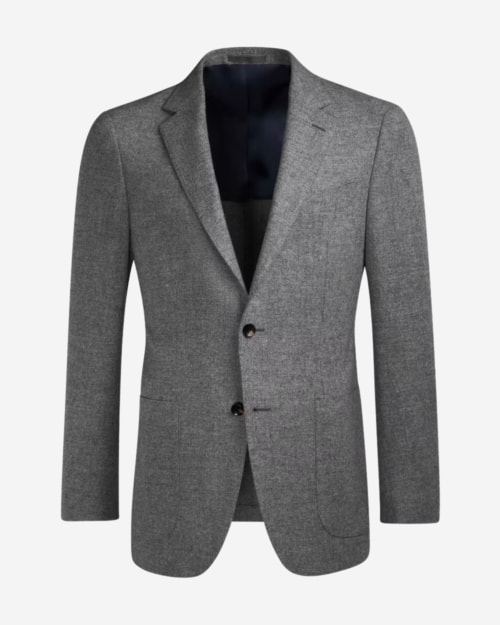
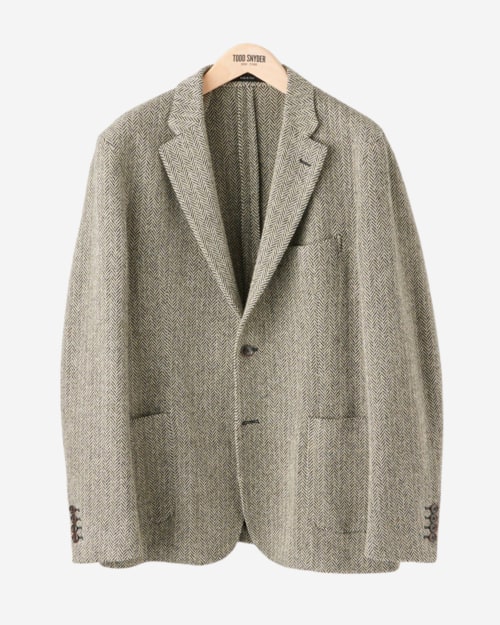
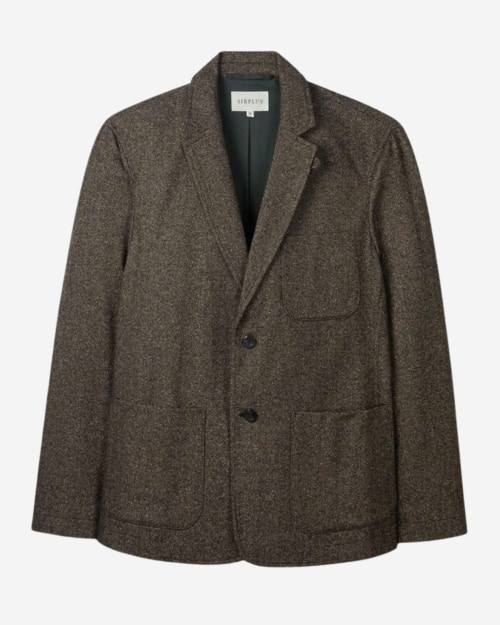
The blazer, or sports coat if we’re using the proper terminology, is one of the cornerstones of business casual, and encapsulates perfectly what the dress code is all about. It’s smart and professional but without the formality of a razor-sharp suit jacket.
It’s extremely versatile within the context of a business casual wardrobe too, and can be used to dress up garments that lean more towards the casual end of the spectrum.
Chinos
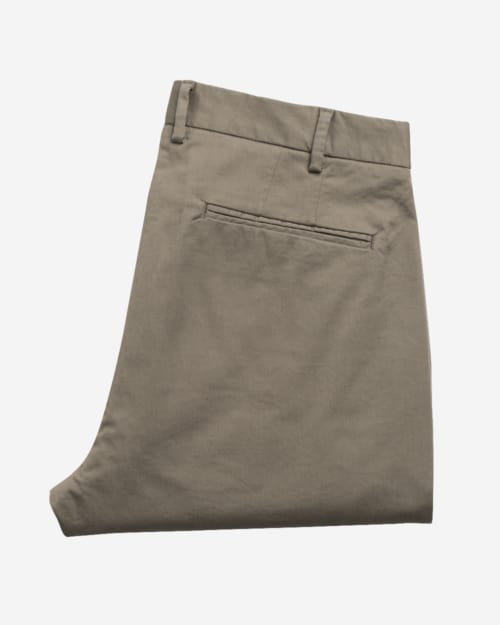
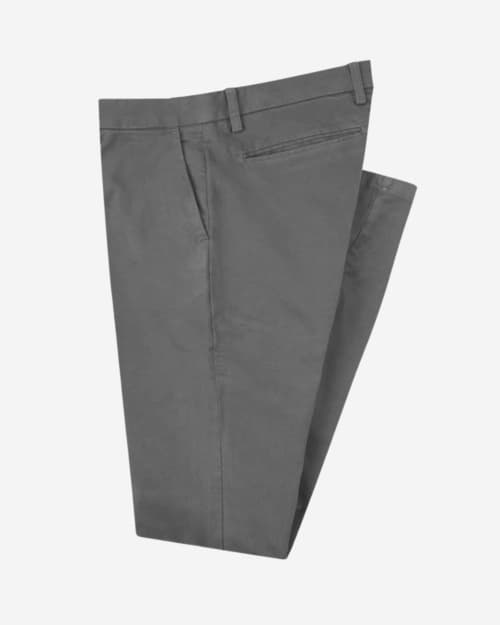
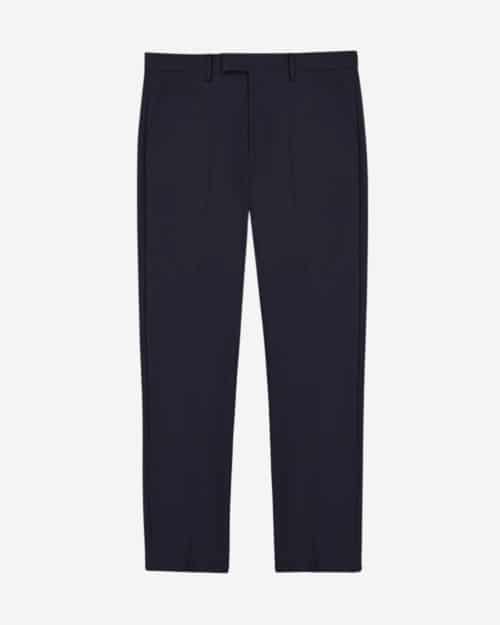
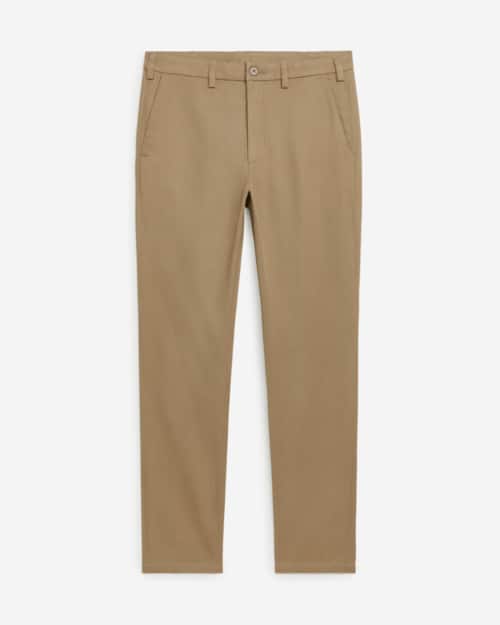
Whether you’re a fan of the preppy energy chinos bring to the business casual arena or not is beside the point. The fact of the matter is that these flat-fronted pants are one of the most traditional components of the dress code.
They perfectly straddle the line between smart and casual, offering a step up in formality from denim, while providing a more laid-back alternative to suit pants.
Dress pants
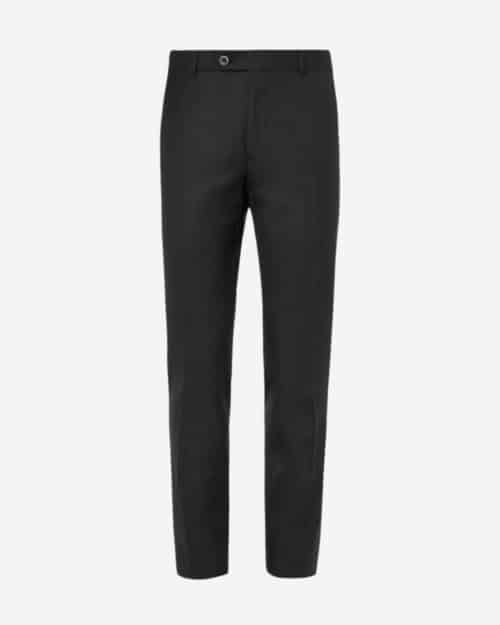
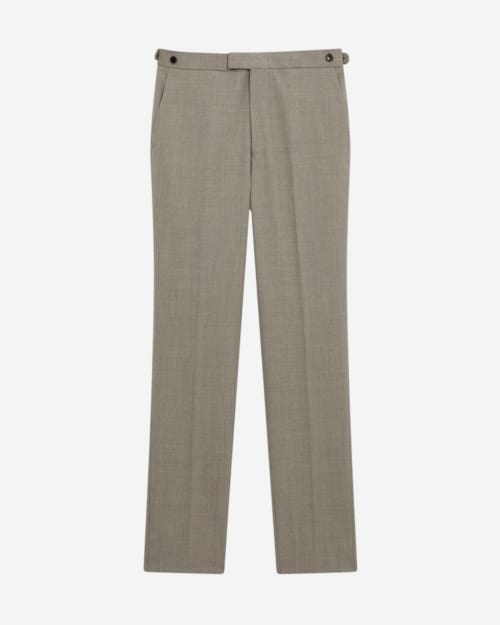
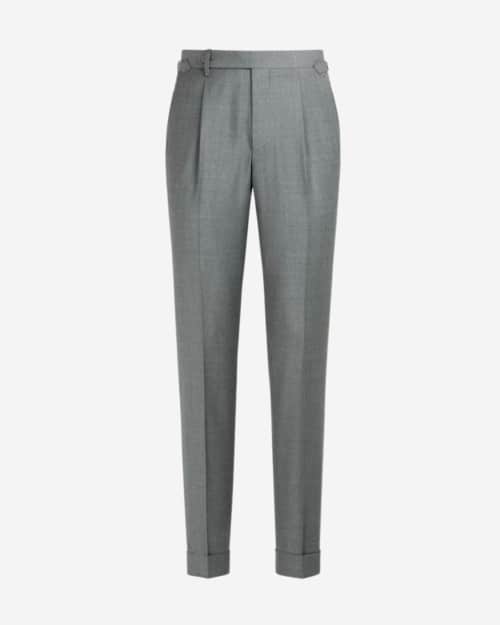
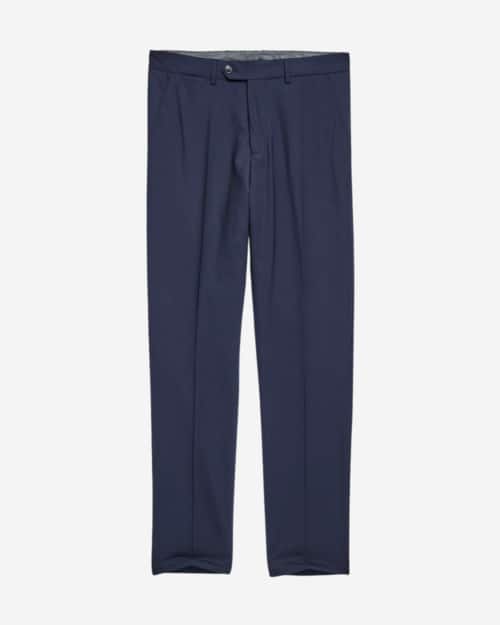
Cotton dress pants are our go-to legwear when it comes to business casual. They’re smarter than a chino, which gives you more leeway to stray into casual territory elsewhere in the outfit.
If you want to take the formality up another notch, go for worsted wool instead of cotton.
Derby shoes
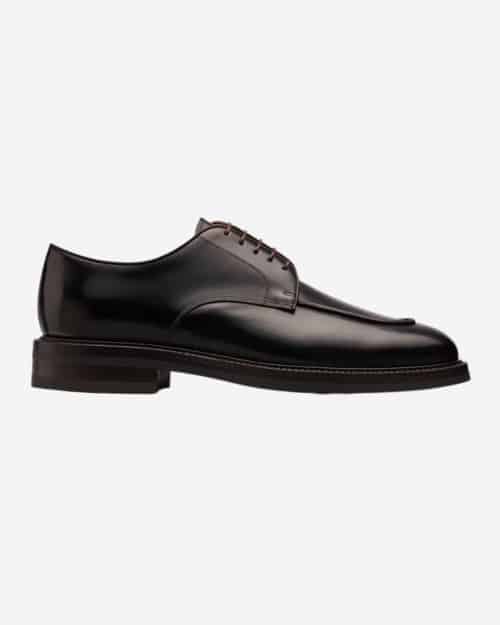

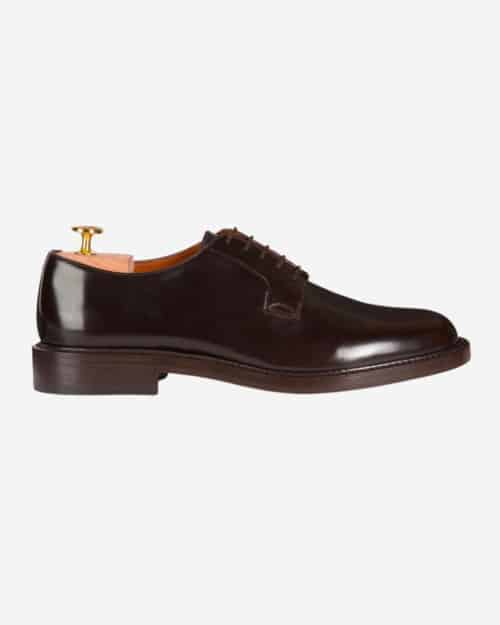
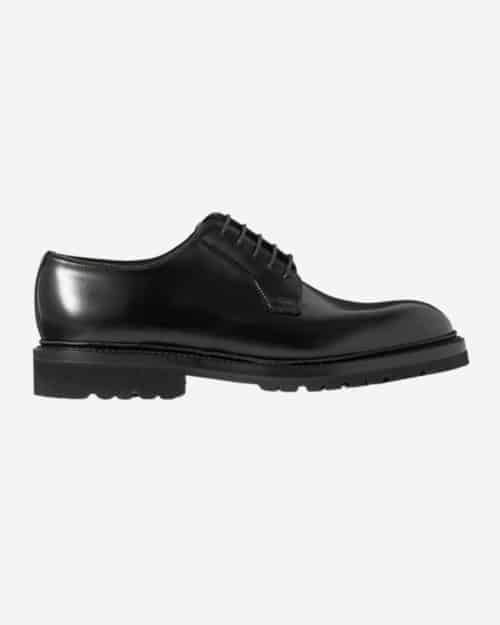
A good pair of leather Derbies is the most obvious choice when it comes to business casual footwear. They’re smart, but not formal like an Oxford, and are versatile enough to be dressed up or down depending on the situation.
Loafers
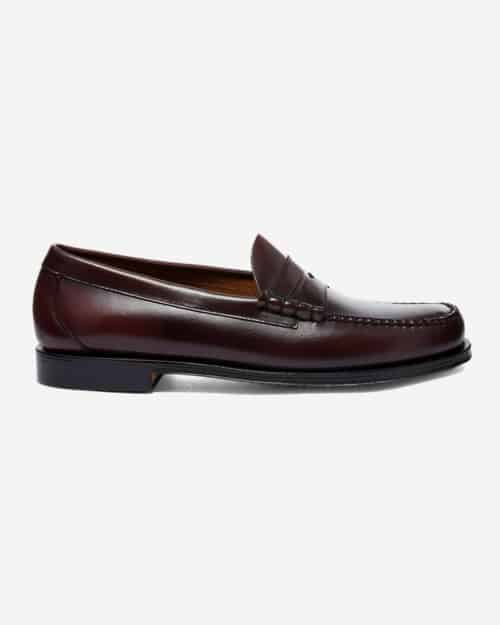
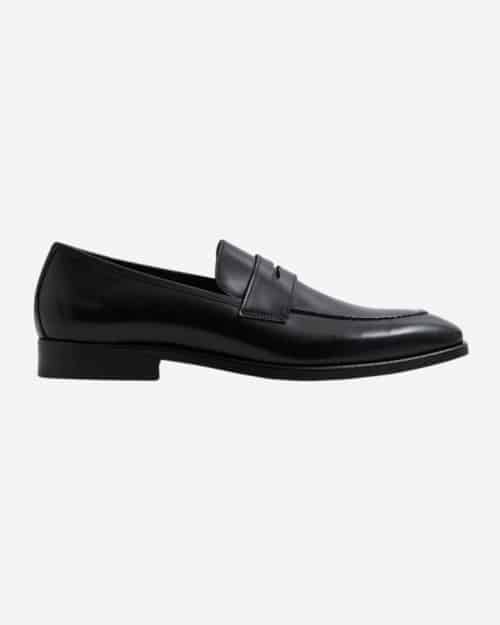
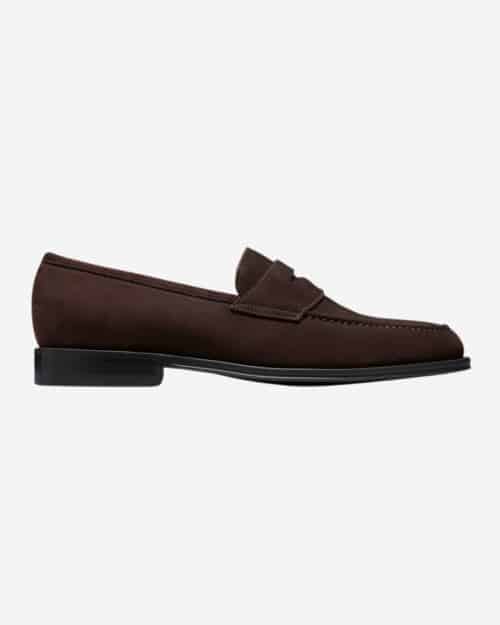
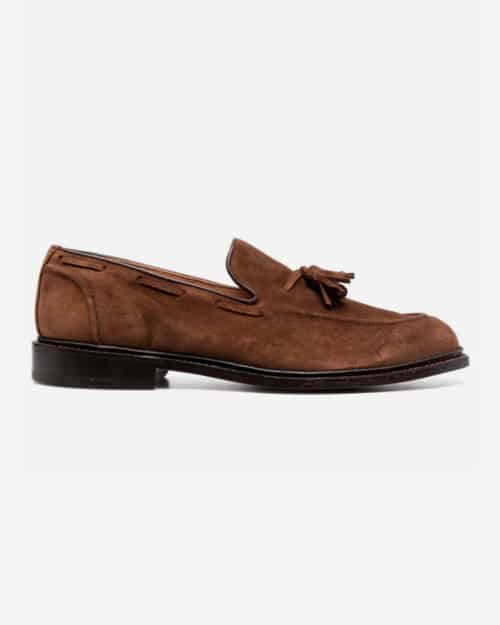
The right pair of loafers can be a valuable addition to your business casual footwear lineup. They can lend smarter outfits a louche, laid-back air, and are a great contemporary alternative to the tried-and-tested classics.
Knitwear
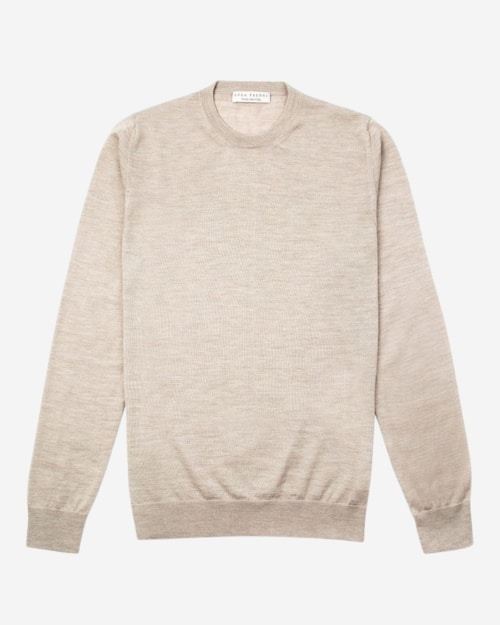
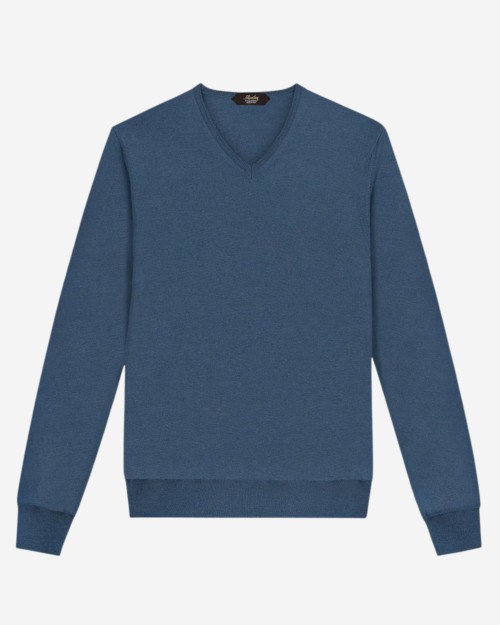
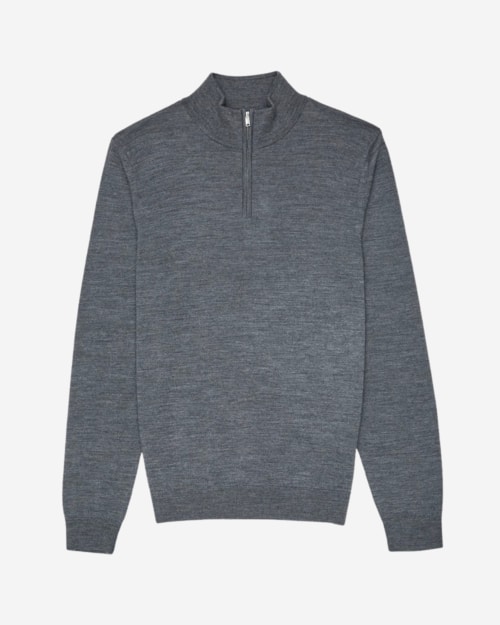

A selection of knitwear is a must when it comes to crafting a solid business casual wardrobe. Crew necks and V-necks are great for wearing over shirts, and cardigans and quarter-zips are perfect for layering up in the colder months.
Always opt for a light, fine-gauge knit over anything too textured or heavy. Think merino wool or cashmere over chunky wool cable knits.
Polo Shirt
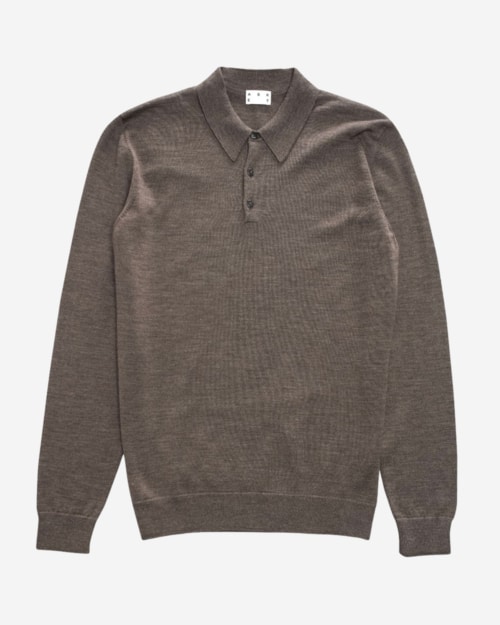
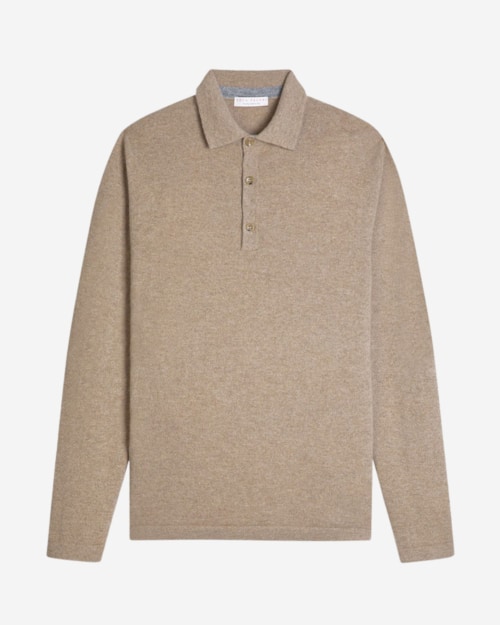
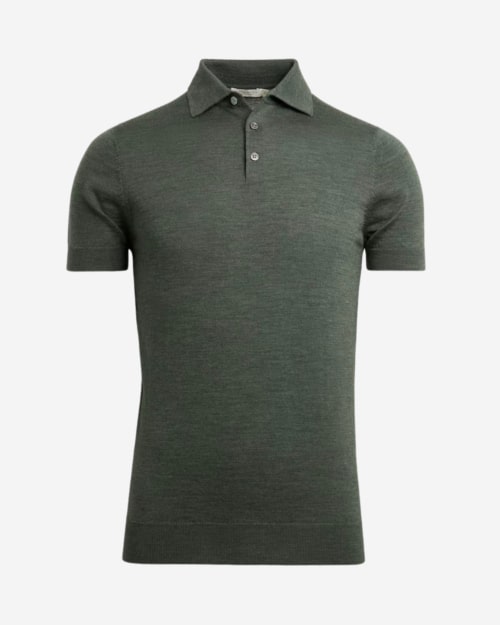
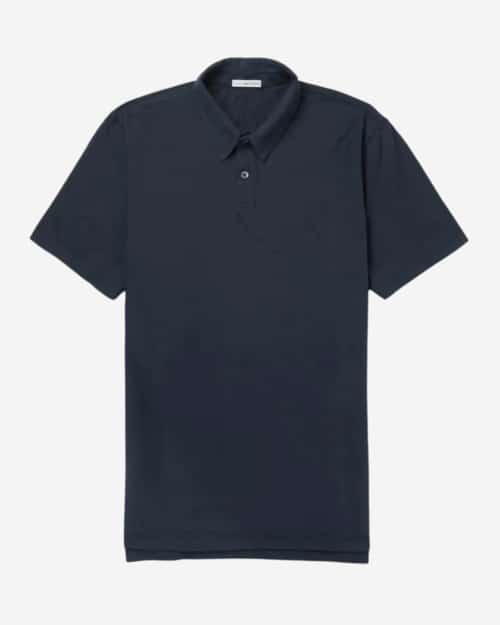
T-shirts might be off the table, but that doesn’t mean you’re confined solely to shirts. A polo shirt is a great summer alternative that can look very smart when worn tucked into dress pants with a blazer or knitted sweater.
Oxford shirt
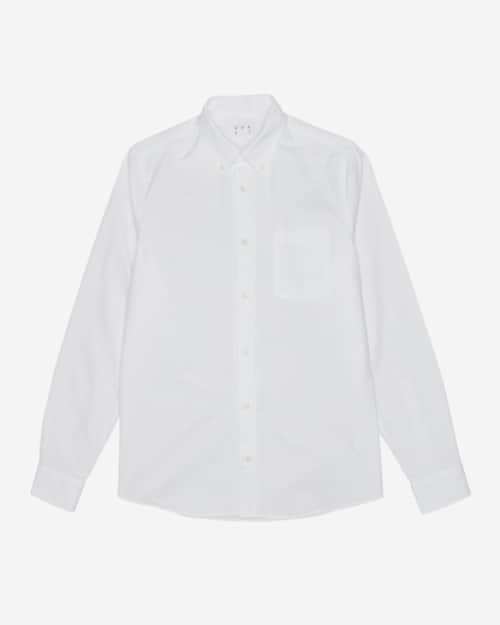
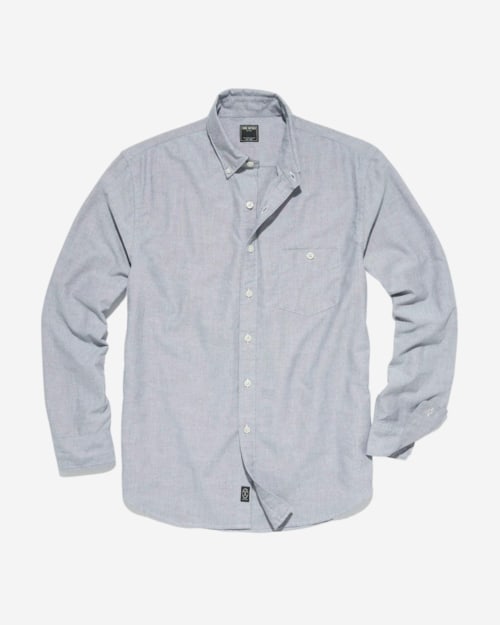
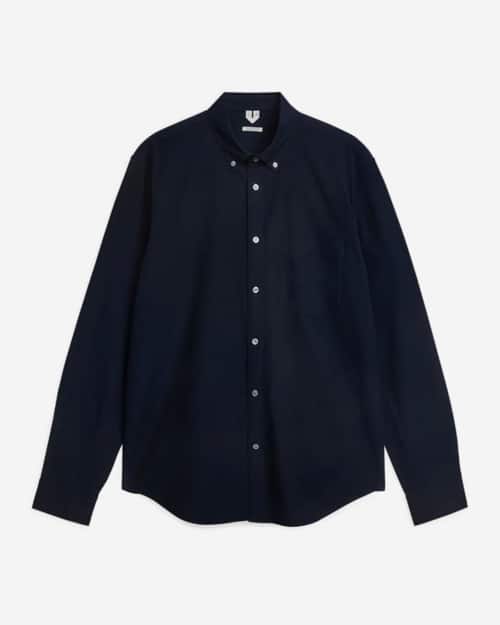
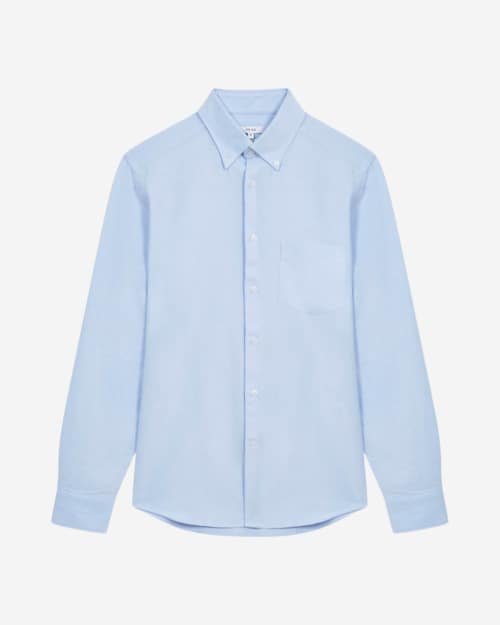
A classic Oxford shirt, with its button-down collar and lightly textured fabric, is just the right balance of smart and relaxed to work perfectly for business casual.
It’s a less formal alternative to a poplin dress shirt, and looks great when layered with knitwear, blazers and smart outerwear.
Unstructured suits
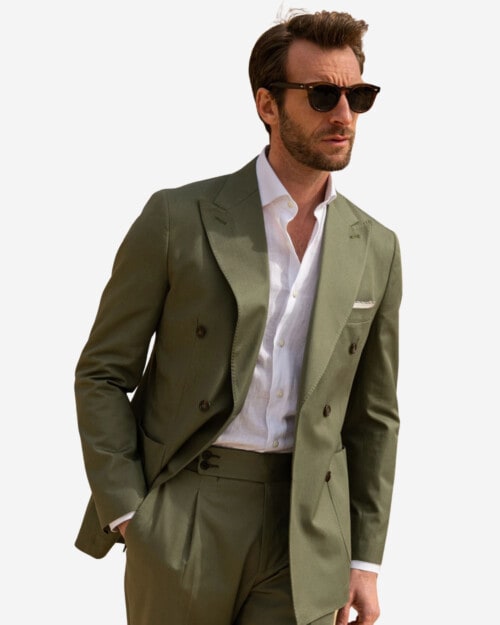
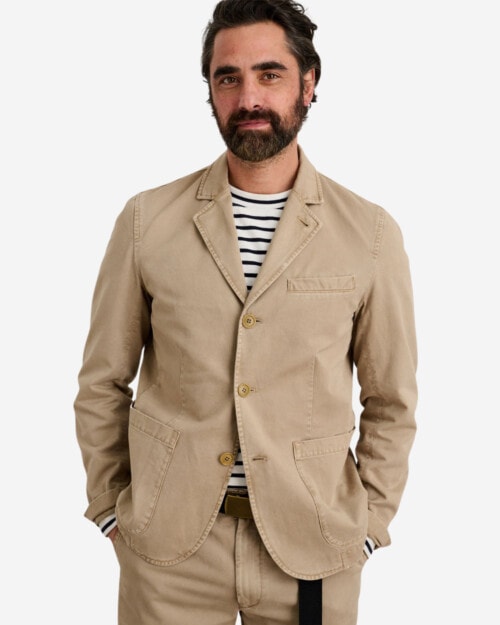
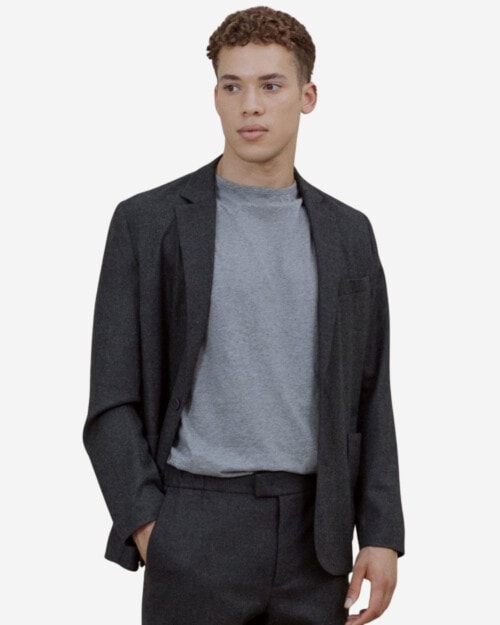
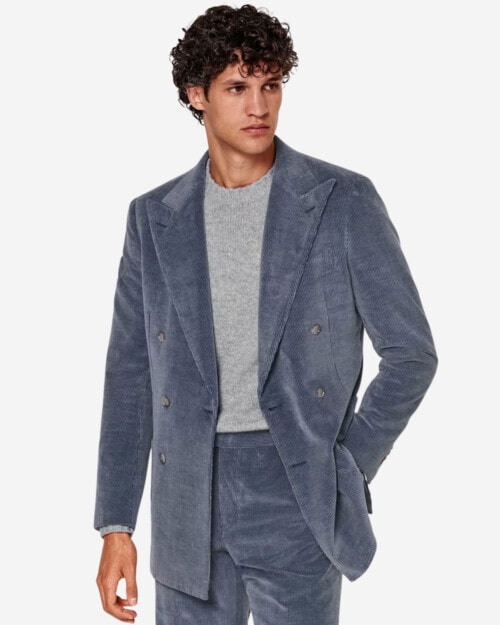
There was a time not all that long ago when the lounge suit was the businessman’s coat of armor, thanks to full canvassing creating a strong structure that scaffolded one’s torso. However, unstructured suiting – that is, suits without any internal structure and padding – is par for the course now.
The benefits are myriad. Unstructured jackets are versatile, drape really naturally and super comfortable to wear in the office. Plus, because the blazer is lightweight and fluid, it can be styled in a variety of semi-casual ways: layered over a T-shirt or crew-neck jumper, or with a traditional shirt and tie combination.
Turtleneck
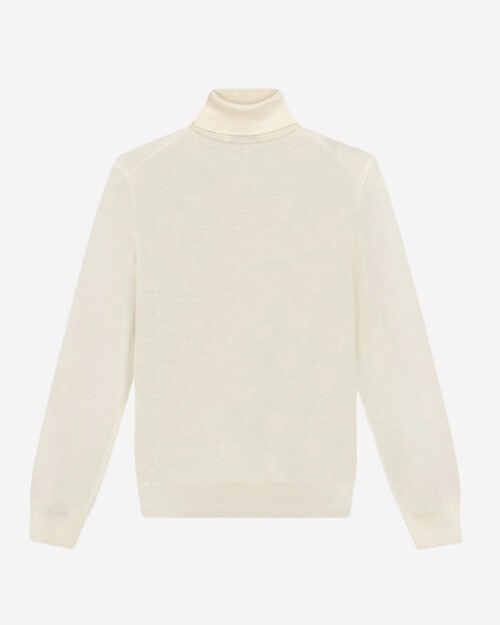
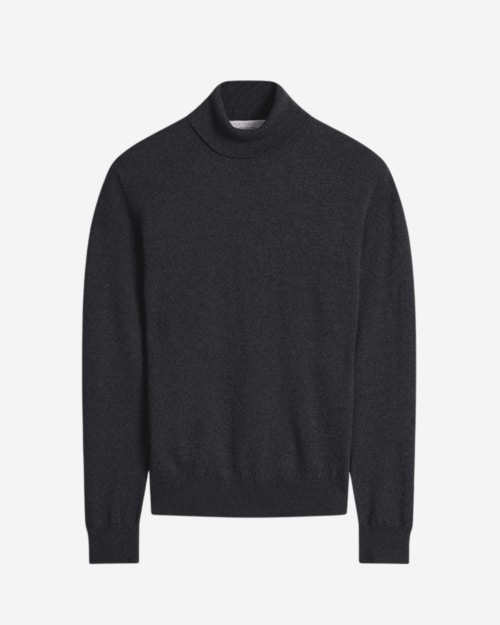
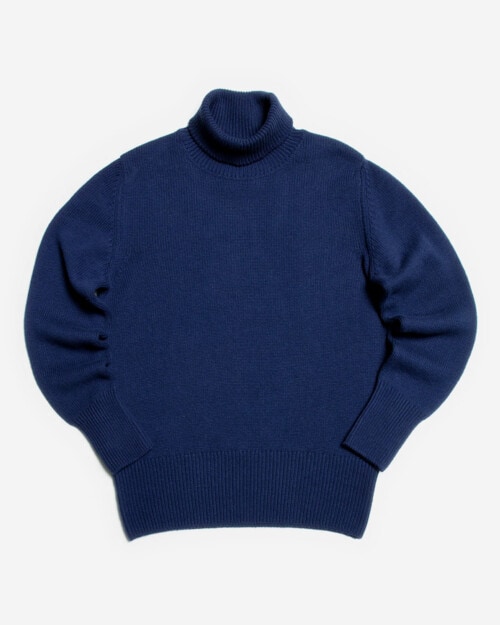
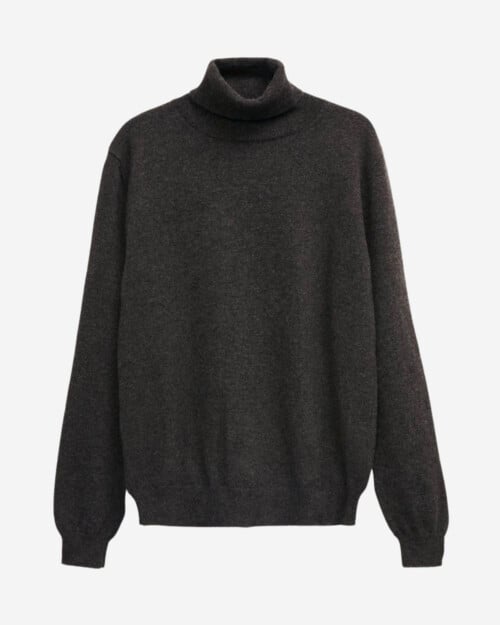
In the last decade, the turtleneck has enjoyed something of a business casual renaissance as the shirt-and-tie combination so beloved of generations before us took a back seat. Fine-gauge, super-fine wool yarns have enabled the turtleneck to fill the vacuum left by the shirt, offering a comfortable alternative in most climates, thanks to wool’s superior moisture-wicking and temperature-regulating properties.
Today, the turtleneck has become prime business casual real estate, proving a great way to inject both color and texture into your looks. Under a suit, it makes for a masculine, rebellious look with equal parts sophistication and elegance, while it also combines nicely with tailored separates or dress pants and a blouson or overshirt.
Elevated casual jacket
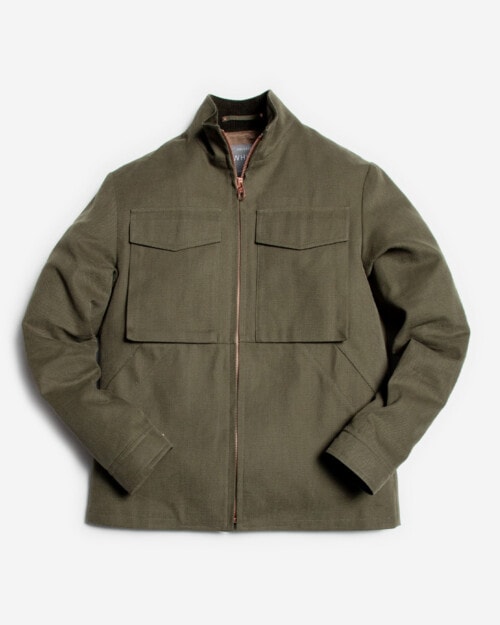
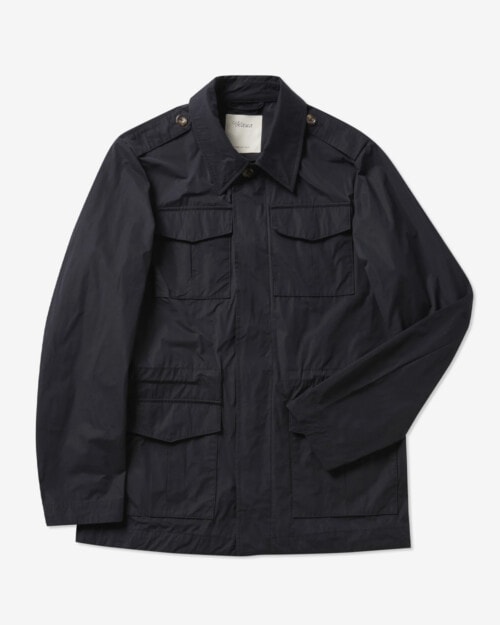
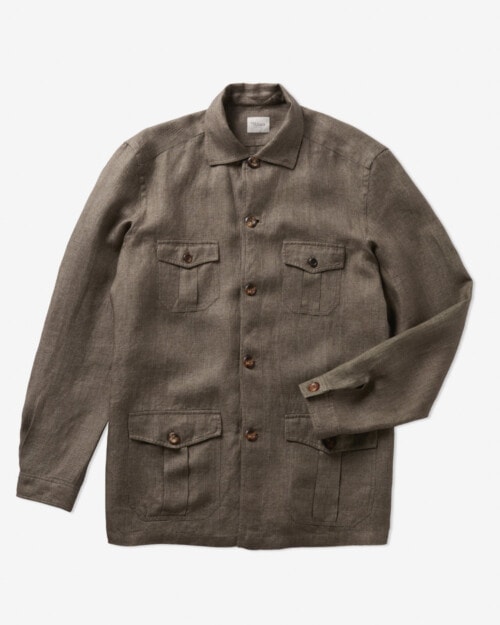
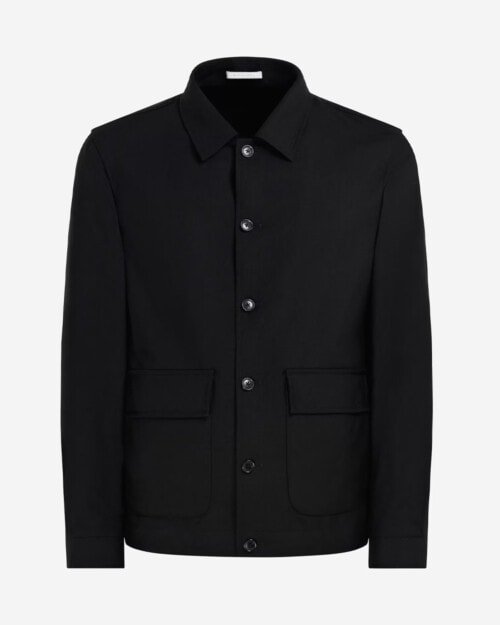
You’ll need to take the sartorial temperature of your workplace before pushing the envelope of your business casual wardrobe, but if yours is the type of office to not demand suits or separates, then you open up a huge number of styling options.
This might sound great on paper, but in reality it could just make looking good day-in day-out a little more complicated. The temptation would be to just veer into casual and forget about the ‘business’, which is why having a form of jacket always keeps the casual element from straying too far.
Contemporary jacket styles are many and varied, so there is no shortage of options. Cropped blousons and shackets in lightweight cotton or linen fabrics are excellent spring/summer options since they have a classic turned-down collar. In fall and winter, utilitarian silhouettes such as field jackets and belted safari jackets make for a masculine outer layer, especially when paired with the aforementioned turtleneck jumper.
Smart sneakers
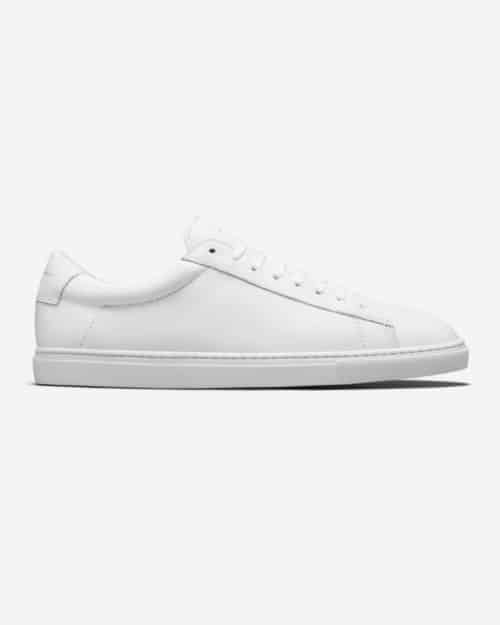
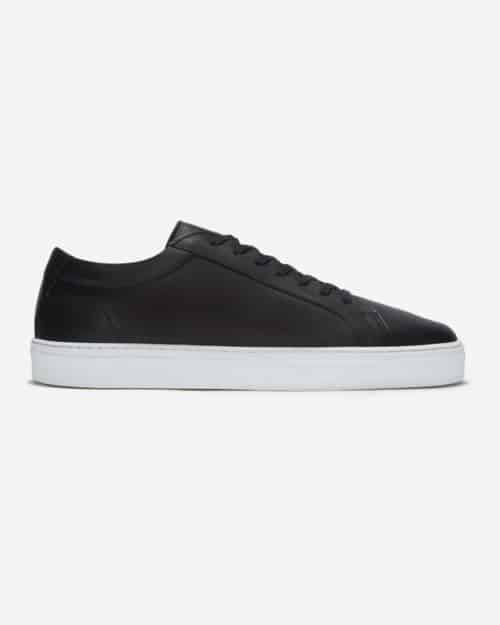
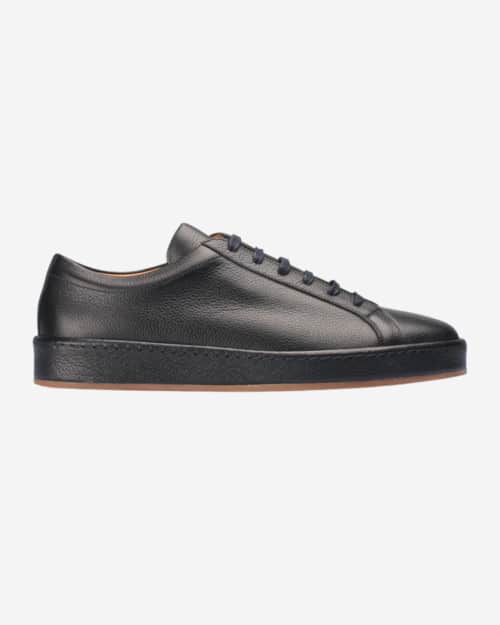
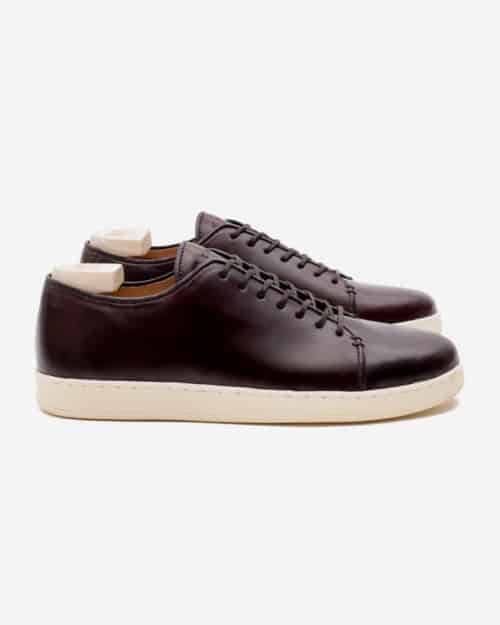
The advent of premium, minimalist sneakers has granted athletic footwear access to all sorts of environments from which it was previously banished. The office is one such place. And while the most conservative of workplaces might not quite have caught up yet, we firmly believe that, for most settings, smart leather sneakers are very much a part of the modern business casual uniform.
Business casual FAQs
Hopefully the information in this guide has already answered your burning business casual questions. But just in case, here are the answers to some of the most common queries men have about the dress code.
Are sneakers business casual?
Ten or 20 years ago, the answer to this question would have been a firm no, but things have changed a lot since then. These days, there aren’t many places sneakers can’t go, but it’s still important to buy the right ones.
If you’re brave enough to mix some sneakers into your business casual looks, keep detail and branding to to the bare minimum, materials high quality and the shape and style simple. We’d encourage you to stick to leather in dark colors too.
Are T-shirts business casual?
It’s best to avoid T-shirts for business casual, unless you’re layering it underneath a sweater or a shirt as a base layer. There’s an argument to be made for wearing one under a blazer and tucked into your trousers, but it’s best left alone if you’re in any way unsure.
Does business casual require tailoring?
It’s usually a good idea to have at least one tailored piece per business casual outfit, whether that be a pair of dress pants or a blazer.
Are suits business casual?
The whole point of the business casual dress code is that it doesn’t require a suit. So no, technically speaking, a full suit is not really considered business casual, unless it’s an unstructured version in a non-traditional color or textured fabric.
When should I wear business casual?
Wear business casual for work if your office requires you to be well turned out and smart, but doesn’t make full suits compulsory. It’s a more comfortable alternative to tailoring, but more office-appropriate than smart casual.
Are chinos business casual?
Chinos are one of the cornerstones of business casual attire but wear them with dressier pieces to avoid looking overly casual.
Should I wear a blazer for business casual?
You can, but you don’t have to. Not every business casual outfit calls for a blazer, but it can sometimes help to elevate less formal garments and bring a look together. On the whole, the blazer is one of the key components of the business casual dress code.
What shirt is best for business casual?
An Oxford button-down shirt or a poplin button-up shirt are two of the best options for business casual shirting. Stick to plain, neutral tones, or subtle pastels if you want to add a dash of color.
Is knitwear business casual?
It really depends on the knitwear. Stay away from anything overly textured, heavyweight, patterned or colorful and you should be good. Fine-gauge knits are usually best as they’ll often need to fit underneath a blazer.
Some key styles include cardigans, roll necks, crew-neck sweaters and quarter-zips.
Are loafers business casual?
A leather loafer is an excellent alternative to a traditional Derby shoe that offers a slightly more relaxed feel. It can work nicely when dressed up with smarter pieces, like tailored pants and a blazer, and has the added benefit of being rather comfortable too.
